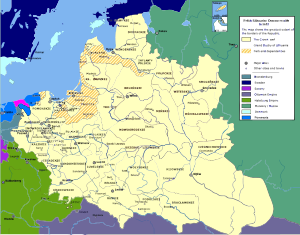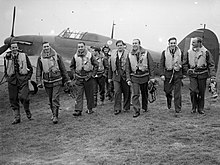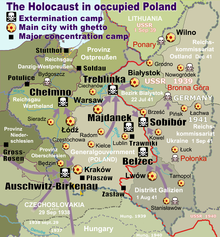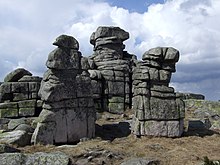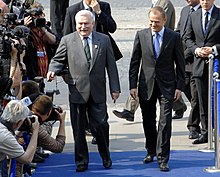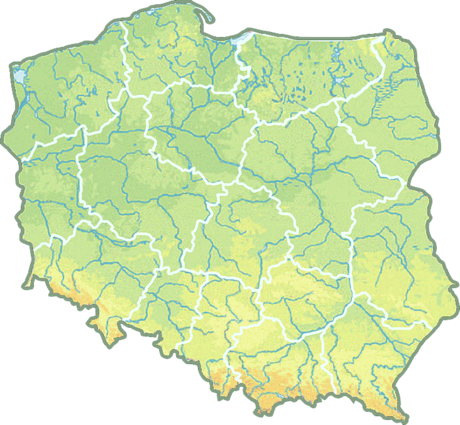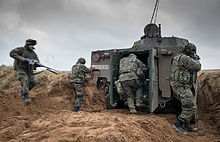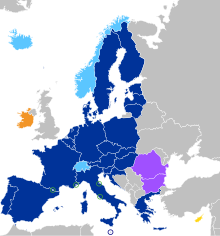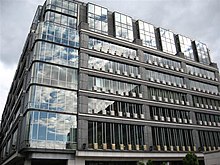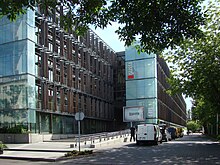Republic of Poland
Rzeczpospolita Polska (Polish)
|
|
|
Anthem:
Mazurek Dąbrowskiego
Poland Is Not Yet Lost
|
Location of Poland (dark green)
|
Capital
and largest city |
Warsaw
52°13′N 21°02′E / 52.217°N 21.033°E / 52.217; 21.033 |
| Official language |
Polish[1] |
| Regional language |
Kashubian[2] |
| Ethnic groups (2011) |
|
| Demonym |
|
| Government |
Parliamentary republic |
| - |
President |
Bronisław Komorowski |
| - |
Prime Minister |
Ewa Kopacz |
| Legislature |
National Assembly |
| - |
Upper house |
Senate |
| - |
Lower house |
Sejm |
| Formation |
| - |
Christianization[b] |
14 April 966 |
| - |
Kingdom of Poland |
18 April 1025 |
| - |
Polish–Lithuanian Commonwealth |
1 July 1569 |
| - |
Partition of Poland |
24 October 1795 |
| - |
Duchy of Warsaw |
22 July 1807 |
| - |
Congress Poland |
9 June 1815 |
| - |
Reconstitution of Poland |
11 November 1918 |
| - |
Invasion of Poland, World War II |
1 September 1939 |
| - |
Communist Poland |
8 April 1945 |
| - |
Republic of Poland |
13 September 1989 |
| - |
Joined the European Union |
1 May 2004 |
| Area |
| - |
Total |
312,679 km2[a] (71st)
120,696.41 sq mi |
| - |
Water (%) |
3.07 |
| Population |
| - |
30 June 2014 estimate |
38,483,957 [3] (34th) |
| - |
2011 census |
38,511,824[4] (34th) |
| - |
Density |
123/km2 (83rd)
319.9/sq mi |
| GDP (PPP) |
2015 estimate |
| - |
Total |
$990.568 billion[5] (21st) |
| - |
Per capita |
$25,703 (49th) |
| GDP (nominal) |
2015 estimate |
| - |
Total |
$593.758 billion[5] (23rd) |
| - |
Per capita |
$15,406 (54th) |
| Gini (2012) |
 30.9[6] 30.9[6]
medium |
| HDI (2013) |
0.834[7]
very high · 35th |
| Currency |
Złoty (PLN) |
| Time zone |
CET (UTC+1) |
| - |
Summer (DST) |
CEST (UTC+2) |
| Drives on the |
right |
| Calling code |
48 |
| ISO 3166 code |
PL |
| Internet TLD |
.pl |
| a. |
^a The area of Poland, as given by the Central Statistical Office, is 312,679 km2 (120,726 sq mi), of which 311,888 km2 (120,421 sq mi) is land and 791 km2 (305 sq mi) is internal water surface area.[8] |
| b. |
^b The adoption of Christianity in Poland is seen by many Poles, regardless of their religious affiliation or lack thereof, as one of the most significant events in their country's history, as it was used to unify the tribes in the region.[9] |
Poland (
Polish:
Polska;
pronounced [ˈpɔlska] ( listen)
listen)), officially the
Republic of Poland (
Polish:
Rzeczpospolita Polska;
pronounced [ʐɛt͡ʂpɔˈspɔʎit̪a ˈpɔlska] ( listen)
listen)), is a country in
Central Europe bordered by
Germany to the west; the
Czech Republic and
Slovakia to the south;
Ukraine and
Belarus to the east; and the
Baltic Sea,
Kaliningrad Oblast (a
Russian exclave) and
Lithuania to the north. The total
area of Poland is 312,679 square kilometres (120,726 sq mi),
[8] making it the
71st largest country in the world and the 9th largest in Europe. With a population of over 38.5 million people,
[8] Poland is the
34th most populous country in the world,
[10] the sixth most populous
member of the European Union, and the most populous
post-communist member of the European Union. Poland is a
unitary state divided into 16
administrative subdivisions.
Many historians trace the establishment of a Polish state to 966, when
Mieszko I,
[11] ruler of a territory roughly coextensive with that of present-day Poland, converted to Christianity. The
Kingdom of Poland was founded in 1025, and in 1569 it cemented
a longstanding political association with the
Grand Duchy of Lithuania by signing the
Union of Lublin, forming the
Polish–Lithuanian Commonwealth. The Commonwealth gradually ceased to exist in the years 1772–1795, when the
Polish territory was partitioned among
Prussia, the
Russian Empire, and
Austria.
Poland regained its independence (as the
Second Polish Republic) at the end of
World War I, in 1918.
Two decades later, in September 1939,
World War II started with the invasions of Poland by
Nazi Germany and the
Soviet Union (as part of the
Molotov–Ribbentrop Pact). More than six million Polish citizens died in the war.
[12][13][14][15] In 1944, a Soviet-backed
Polish provisional government was formed which, after a period of conflict, falsified
a referendum and
an election, giving rise to a
satellite state[16] of the
Soviet Union,
Polish Republic (
Rzeczpospolita Polska), renamed to the
People's Republic of Poland (
Polska Rzeczpospolita Ludowa) in 1952. During the
Revolutions of 1989, Poland's Marxist–Leninist government was overthrown and Poland adopted a new constitution establishing itself as a democracy under the name
Rzeczpospolita Polska, often referred to as the "
Third Polish Republic" (
III Rzeczpospolita).
Despite
the vast destruction the country
experienced during World War II, Poland managed to preserve much of its
cultural wealth. There are 14 heritage sites inscribed on the
UNESCO World Heritage[17] and 54
Historical Monuments and many
objects of cultural heritage. Since the end of the
communist period, Poland has achieved a "very high" ranking in terms of
human development,
[18] as well as gradually improving economic freedom.
[19]
Etymology
The source of the name Poland
[20] and the
ethnonyms for the
Poles[21] include
endonyms (the way Polish people refer to themselves and their country) and exonyms (the way other peoples refer to the Poles and their country). Endonyms and most exonyms for Poles and Poland derive from the name of the
West Slavic tribe of the
Polans (
Polanie).
The origin of the name
Polanie itself is uncertain. It may derive from such Polish words as
pole (field).
[22] The early tribal inhabitants denominated it from the nature of the country. Lowlands and low hills predominate throughout the vast region from the
Baltic shores to the foothills of the
Carpathian Mountains. "Between the Alps, Hungary, and the ocean, lies Poland, which is called in their native tongue Campania" (
Latin:
"Inter Alpes Huniae et Oceanum est Polonia, sic dicta in eorum idiomate quasi Campania") is the description by
Gervase of Tilbury in his
Otia imperialia ("Recreation for the Emperor") of 1211. In some languages the exonyms for Poland derive from another tribal name,
Lechites (
Lechici).
History
Prehistory and protohistory of Poland

Historians have postulated that throughout
Late Antiquity, many distinct ethnic groups populated the regions of what is now Poland. The
ethnicity and
linguistic affiliation of these groups have been hotly debated; the time and route of the original settlement of
Slavic peoples in these regions lacks written records and can only be defined as fragmented.
[23]
The most famous archaeological find from
the prehistory and protohistory of Poland is the
Biskupin fortified settlement (now reconstructed as an open air museum), dating from the
Lusatian culture of the early
Iron Age, around 700 BC. The Slavic groups who would form Poland migrated to these areas in the second half of the 5th century AD. Up until the creation of
Mieszko's state and his subsequent conversion to Christianity in 966 AD, the main religion of Slavic tribes that inhabited the geographical area of present-day Poland was
Slavic paganism. After the
Baptism of Poland the new religion accepted by the Polish ruler was Catholicism. The transition to
Christianity was not a smooth and instantaneous process for the rest of the population as evident from the
pagan reaction of the 1030s.
[24]
Piast dynasty
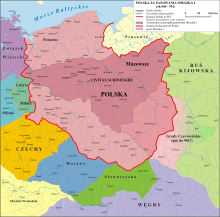
Map of Poland under the rule of
Mieszko I, who is considered the
de facto creator of the Polish state, ca. 960–992
Poland began to form into a recognizable unitary and
territorial entity around the middle of the 10th century under the
Piast dynasty. Poland's first
historically documented ruler,
Mieszko I, accepted
Baptism in 966 and adopted
Christianity as the new
official religion of his subjects. The bulk of
the population converted in the course of the next few centuries. In 1000,
Boleslaw the Brave, continuing the policy of his father Mieszko, held a
Congress of Gniezno and created the
metropolis of
Gniezno and the
dioceses of
Kraków,
Kołobrzeg, and
Wrocław. The pagan unrest however, led to the transfer of the capital to Kraków in 1038 by
Casimir I the Restorer.
[25]
Prince
Bolesław III Wrymouth defeated the King of Germany
Henry V in the 1109
Battle of Hundsfeld, writes
Gallus Anonymus in
his 1118 chronicle.
[26] In 1138, Poland fragmented into several smaller duchies when Bolesław divided his lands among his sons. In 1226,
Konrad I of Masovia, one of the regional
Piast dukes, invited the
Teutonic Knights to help him fight the
Baltic Prussian pagans; a decision which led to centuries of warfare with the Knights. Elements of
what is called now human rights may be found in early times of the Polish state. The
Statute of Kalisz or the General Charter of Jewish Liberties (issued in 1264) introduced numerous right for the Jews in Poland, leading to a nearly autonomous "nation within a nation".
[27]
In the middle of 13th-century the Silesian branch of the Piast dynasty (
Henry I the Bearded and
Henry II the Pious, ruled 1238–1241) almost succeeded in uniting the Polish lands, but the
Mongols devastated the country and won the
Battle of Legnica where Duke
Henry II the Pious died (1241). In 1320, after a number of earlier unsuccessful attempts by regional rulers at uniting the Polish dukedoms,
Władysław I consolidated his power, took the throne and became the first King of
a reunified Poland. His son,
Casimir III (reigned 1333–1370), has a reputation as one of the greatest Polish kings, and gained wide recognition for improving the country's infrastructure.
[28][29] Casimir also extended royal protection to
Jews, and encouraged their immigration to Poland.
[28][30]

Casimir III the Great is the only Polish king who received the title of
"Great". He built extensively during his reign, and reformed the Polish army and the country's civil and criminal law, 1333–1370
The education of Polish society was a goal of rulers as early as the 12th century, and Polish nobility became one of the most educated groups in Europe.
[31][32] The library catalogue of the Cathedral Chapter of
Kraków dating back to 1110 shows that in the early 12th-century Polish intellectuals had access to European literature.
Casimir III realized that the nation needed a class of educated people, especially lawyers, who could codify the country's laws and administer the courts and offices. His efforts to found an institution of higher learning in Poland were finally rewarded when
Pope Urban V granted him permission to open the University of Kraków.
The
Golden Liberty of the nobles began to develop under Casimir's rule, when in return for their
military support, the king made serious concessions to the aristocrats, finally establishing their status as superior to that of the townsmen, and aiding their rise to power. When Casimir died in 1370 he left no legitimate male heir and, considering his other male descendants either too young or unsuitable, was laid to rest as the last of the nation's Piast rulers.
Poland also became a magnet for migrants. Germans settled in the towns; the
Jewish community began to settle and flourish in Poland during this era (see
History of the Jews in Poland); the same applies in smaller number to
Armenians. The
Black Death which afflicted most parts of Europe from 1347 to 1351 affected Poland less severely.
[33][34]
Jagiellon dynasty

The rule of the
Jagiellon dynasty spanned the late
Middle Ages and early
Modern Era of Polish history. Beginning with the
Lithuanian Grand Duke Jogaila (Władysław II Jagiełło), the Jagiellon dynasty (1386–1572) formed the
Polish–Lithuanian union. The partnership brought vast
Lithuania-controlled
Rus' areas into Poland's sphere of influence and proved beneficial for the Poles and
Lithuanians, who coexisted and cooperated in one of the largest
political entities in Europe for the next four centuries. In the Baltic Sea region Poland's struggle with the Teutonic Knights continued and included the
Battle of Grunwald (1410), where a Polish-Lithuanian army inflicted a decisive defeat on the Teutonic Knights, both countries' main adversary, allowing Poland's and Lithuania's territorial expansion into the far north region of
Livonia.
[35] In 1466, after the
Thirteen Years' War, King
Casimir IV Jagiellon gave royal consent to the milestone
Peace of Thorn, which created the future
Duchy of Prussia, a Polish vassal. The Jagiellons at one point also established dynastic control over the kingdoms of
Bohemia (1471 onwards) and
Hungary.
[36][37] In the south Poland confronted the
Ottoman Empire and the
Crimean Tatars (by whom they were attacked on 75 separate occasions between 1474 and 1569),
[38] and in the east helped Lithuania fight the
Grand Duchy of Moscow. Some historians estimate that Crimean Tatar slave-raiding cost Poland one million of its population from 1494 to 1694.
[39]

Wawel Castle in
Kraków; the seat of Polish kings from 1038 until the capital was move to
Warsaw in 1596. The royal residence is an early example of
Renaissance architecture in Poland
Poland was developing as a
feudal state, with a predominantly agricultural economy and an increasingly powerful
landed nobility. The
Nihil novi act adopted by the Polish
Sejm (parliament) in 1505, transferred most of the
legislative power from the monarch to the Sejm, an event which marked the beginning of the period known as "Golden Liberty", when the state was ruled by the "free and equal"
Polish nobility.
Protestant Reformation movements made deep inroads into Polish Christianity, which resulted in the establishment of policies promoting
religious tolerance, unique in Europe at that time.
[40] This tolerance allowed the country to avoid most the religious turmoil that spread over Europe during the late Middle Ages.
[40] The European
Renaissance evoked in late Jagiellon Poland (kings
Sigismund I the Old and
Sigismund II Augustus) a sense of urgency in the need to promote a
cultural awakening, and during this period Polish culture and the nation's economy flourished. In 1543 the Pole,
Nicolaus Copernicus, an astronomer from
Toruń, published his epochal works,
De revolutionibus orbium coelestium (
On the Revolutions of the Celestial Spheres), and thus became the first proponent of a predictive mathematical model confirming
heliocentric theory which became the accepted basic model for the practice of modern astronomy. Another major figure associated with the era is classicist poet
Jan Kochanowski.
[41]
Polish–Lithuanian Commonwealth
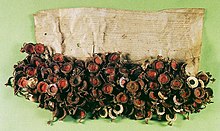
Warsaw Confederation was an important development in the history of Poland that extended religious freedoms and tolerance, and is the first such document in Europe, 28 January 1573
The 1569
Union of Lublin established the
Polish–Lithuanian Commonwealth, a more closely unified federal state with an
elective monarchy, but which was governed largely by the nobility, through a system of
local assemblies with a central parliament. The
Warsaw Confederation (1573) confirmed the
religious freedom of all residents of Poland, which was extremely important for the stability of the multiethnic Polish society of the time.
[27] Serfdom was banned in 1588.
[42] The establishment of the Commonwealth coincided with a period of stability and prosperity in Poland, with the union thereafter becoming a European power and a major cultural entity, occupying approximately one million square kilometers of Central and Eastern Europe, as well as an agent for the dissemination of '
Western culture' through
Polonization in modern-day Ukraine, Belarus and Western Russia.
Poland suffered from a number of dynastic crises during the reigns of the
Vasa kings
Sigismund III and
Władysław IV and found itself engaged in major conflicts with
Russia, Sweden and the Ottoman Empire, as well as a series of minor
Cossack uprisings.
[43] In 1610
Hetman Stanisław Żółkiewski seized Moscow after winning the
Battle of Klushino.
From the middle of the 17th century, the nobles' democracy, suffering from internal disorder, gradually declined, thus leaving the once powerful Commonwealth vulnerable to foreign intervention.
From 1648, the
Cossack Khmelnytsky Uprising engulfed the south and east eventually leaving
Ukraine divided, with the eastern part, lost by the Commonwealth, becoming a dependency of the Tsardom of Russia. This was followed by the
'Deluge', a Swedish invasion, which marched through the Polish heartlands and damaged Poland's population, culture and infrastructure. Around four million of Poland's eleven million population died in famines and epidemics in this period.
[44]
However, under
John III Sobieski the Commonwealth's military prowess was re-established, and in 1683 Polish forces played a major part in
relieving Vienna of a
Turkish siege which was being conducted by
Kara Mustafa in hope of eventually marching his troops further into Europe to spread
Islam.
Sobieski's reign marked the end of the nation's golden-era. Finding itself subjected to almost constant warfare and suffering enormous population losses as well as massive damage to its economy, the Commonwealth fell into decline. The government became ineffective as a result of large-scale internal conflicts (e.g.
Lubomirski Rebellion against
John II Casimir and rebellious
confederations) and corrupted legislative processes. The nobility fell under the control of a handful of
magnats, and this, compounded with two relatively weak kings of the
Saxon Wettin dynasty,
Augustus II and
Augustus III, as well as the rise of
Russia and
Prussia after the
Great Northern War only served to worsen the Commonwealth's plight. Despite this The Commonwealth-Saxony
personal union gave rise to the emergence of the Commonwealth's first reform movement, and laid the foundations for the
Polish Enlightenment.
[45]
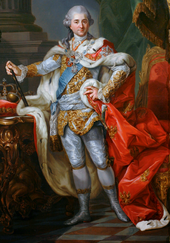
Stanisław II August, the last King of Poland acceded to the throne in 1764, reigning until his abdication on 25 November 1795
During the later part of the 18th century, the Commonwealth made attempts to implement fundamental internal reforms; with the second half of the century bringing a much improved economy, significant population growth and far-reaching progress in the areas of education, intellectual life, art, and especially toward the end of the period, evolution of the social and political system. The most populous capital city of
Warsaw replaced
Gdańsk (Danzig) as the leading centre of commerce, and the role of the more prosperous townsfolk increased.
The
royal election of 1764 resulted in the elevation of
Stanisław II August, a refined and worldly aristocrat connected to a major
magnate faction, to the monarchy. However, a one-time lover of Empress
Catherine II of Russia, the new king spent much of his reign torn between his desire to implement reforms necessary to save his nation, and his perceived necessity to remain in a relationship with his Russian sponsor. This led to the formation of the 1768
Bar Confederation, a
szlachta rebellion directed against Russia and the Polish king that fought to preserve Poland's independence and the
szlachta's traditional privileges. Attempts at reform provoked the union's neighbours, and in 1772 the
First Partition of the Commonwealth by Russia, Austria and Prussia took place; an act which the "
Partition Sejm", under considerable duress, eventually "ratified"
fait accompli.
[46] Disregarding this loss, in 1773 the king established the
Commission of National Education, the first government education authority in Europe.
Corporal punishment of children was officially prohibited in 1783 as first in the world
at all schools.
[47]
The
Great Sejm convened by Stanisław II August in 1788 successfully adopted the
3 May Constitution, the first set of modern supreme national laws in Europe. However, this document, accused by detractors of harbouring revolutionary sympathies, generated strong opposition from the Commonwealth's nobles and conservatives as well as from Catherine II, who, determined to prevent the rebirth of a strong Commonwealth set about planning the final dismemberment of the Polish-Lithuanian state. Russia was aided in achieving its goal when the
Targowica Confederation, an organisation of Polish nobles, appealed to the Empress for help. In May 1792 Russian forces crossed the Commonwealth's frontier, thus beginning the
Polish-Russian War.
The defensive war fought by the Poles ended prematurely when the King, convinced of the futility of resistance, capitulated and joined the Targowica Confederation. The Confederation then took over the government. Russia and Prussia, fearing the mere existence of a Polish state, arranged for, and in 1793 executed, the
Second Partition of the Commonwealth, which left the country deprived of so much territory that it was practically incapable of independent existence. Eventually, in 1795, following the failed
Kościuszko Uprising, the Commonwealth was
partitioned one last time by all three of its more powerful neighbours, and with this, effectively ceased to exist.
[48]
The Age of Partitions
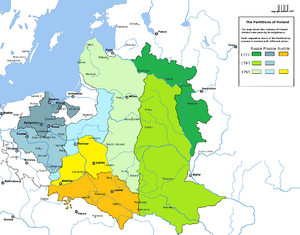
Poles
rebelled several times against the partitioners, particularly near the end of the 18th century and the beginning of the 19th century. An unsuccessful attempt at defending Poland's sovereignty took place in 1794 during the
Kościuszko Uprising, where a popular and distinguished general
Tadeusz Kosciuszko, who had served under
Washington in
America, led Polish insurgents against numerically superior Russian forces. Despite the victory at the
Battle of Racławice, his ultimate defeat ended Poland's independent existence
for 123 years.
[49] In 1807,
Napoleon I of France temporarily recreated a Polish state as a satellite
Duchy of Warsaw, but after the failed
Napoleonic Wars, Poland was again split between the victorious Allies at the
Congress of Vienna of 1815.
[50] The eastern part was ruled by the Russian
tsar as a
Congress Kingdom which possessed a very
liberal constitution. However, the tsars reduced Polish freedoms, and Russia annexed the country in virtually all but name. Thus in the latter half of the 19th century, only Austrian-ruled
Galicia, and particularly the
Free City of Kraków, created good environment for free Polish cultural life to flourish.
Throughout the period of the partitions, political and cultural repression of the Polish nation led to the organisation of a number of uprisings against the authorities of the occupying Russian, Prussian and Austrian governments. Notable among these are the
November Uprising of 1830 and
January Uprising of 1863, both of which were attempts to free Poland from the rule of tsarist Russia. The November uprising began on 29 November 1830 in
Warsaw when, led by Lieutenant
Piotr Wysocki, young
non-commissioned officers at the
Imperial Russian Army's military academy in that city revolted. They were joined by large segments of Polish society, and together forced Warsaw's Russian garrison to withdraw north of the city.
Over the course of the next seven months, Polish forces successfully defeated the Russian armies of Field Marshal
Hans Karl von Diebitsch and a number of other Russian commanders; however, finding themselves in a position unsupported by any other foreign powers, save distant France and the newborn United States, and with
Prussia and
Austria refusing to allow the import of military supplies through their territories, the Poles accepted that the uprising was doomed to failure. Upon the surrender of Warsaw to General
Ivan Paskievich, many Polish troops, feeling they could not go on, withdrew into Germany and there laid down their arms. Poles would have to wait another 32 years for another opportunity to free their homeland.
When in January 1863 a new Polish uprising against Russian rule began, it did so as a spontaneous protest by young Poles against
conscription into the Imperial Russian Army. However, the insurrectionists, despite being joined by high-ranking Polish-Lithuanian officers and numerous politicians were still severely outnumbered and lacking in foreign support. They were forced to resort to
guerrilla warfare tactics. They failed to win any major military victories. Afterwards no major uprising was witnessed in the Russian controlled
Congress Poland and Poles resorted instead to fostering economic and cultural self-improvement.
Despite the political unrest experienced during the partitions, Poland did benefit from large-scale industrialisation and modernisation programs, instituted by the occupying powers, which helped it develop into a more economically coherent and viable entity. This was particularly true in the Greater Poland, Pomerania and Warmia annexed by Prussia (later becoming a part of the
German Empire); an area which eventually, thanks largely to the
Greater Poland Uprising, was reconstituted as a part of the
Second Polish Republic and became one of its most productive regions.
Reconstitution of Poland
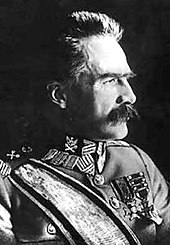
During
World War I, all the
Allies agreed on the reconstitution of Poland that United States President
Woodrow Wilson proclaimed in Point 13 of his
Fourteen Points. A total of 2 million Polish troops fought with the armies of the three occupying powers, and 450,000 died.
[51] Shortly after the
armistice with Germany in November 1918, Poland regained its independence as the
Second Polish Republic (
II Rzeczpospolita Polska). It reaffirmed its independence after
a series of military conflicts, the most notable being the
Polish–Soviet War (1919–1921) when Poland inflicted a crushing defeat on the
Red Army at the
Battle of Warsaw, an event which is considered to have halted the advance of Communism into Europe and forced
Vladimir Lenin to rethink his objective of achieving global socialism. Nowadays the event is often referred to as the "Miracle at the Vistula".
[52]
During this period, Poland successfully managed to fuse the territories of the three former partitioning powers into a cohesive nation state. Railways were restructured to direct traffic towards
Warsaw instead of the former imperial capitals, a new network of national roads was gradually built up and a
major seaport was opened on the
Baltic Coast, so as to allow Polish exports and imports to bypass the politically charged
Free City of Danzig.
The inter-war period heralded in a new era of Polish politics. Whilst Polish political activists had faced heavy censorship in the decades up until the
First World War, the country now found itself trying to establish a new political tradition. For this reason, many exiled Polish activists, such as
Ignacy Paderewski (who would later become Prime Minister) returned home to help; a significant number of them then went on to take key positions in the newly formed political and governmental structures. Tragedy struck in 1922 when
Gabriel Narutowicz, inaugural holder of the Presidency, was assassinated at the
Zachęta Gallery in Warsaw by painter and right-wing nationalist
Eligiusz Niewiadomski.
[53]
The 1926
May Coup of
Józef Piłsudski turned rule of the Second Polish Republic over to the
Sanacja movement. By the 1930s Poland had become increasingly authoritarian; a number of 'undesirable' political parties, such as the Polish Communists, had been banned and following Piłsudski's death, the regime, unable to appoint a new leader, began to show its inherent internal weaknesses and unwillingness to cooperate in any way with other political parties.
World War II

The beginning of
World War II was marked by the
Nazi German invasion of Poland on 1 September 1939, followed by the
Soviet invasion of Poland on 17 September in violation of the
Soviet–Polish Non-Aggression Pact. On 28 September 1939
Warsaw capitulated. As agreed earlier in the
Molotov–Ribbentrop Pact, Poland was split into two occupied zones,
one subdivided by Nazi Germany, while the other, including all of eastern
Kresy fell under
the control of the Soviet Union. In 1939–1941, the Soviets had deported hundreds of thousands of Poles out to the most distant parts of the Soviet Union. The Soviet
NKVD secretly executed thousands of Polish prisoners of war (inter alia
Katyn massacre) ahead of the
Operation Barbarossa.
[54]
All in all, Poland made the fourth-largest troop contribution to
the Allied war effort, after the
Soviets, the British, and the Americans.
[a] Polish troops fought under the command of both the
Polish Government in Exile in the
theatre of war west of Germany and under Soviet leadership in the theatre of war east of Germany. The Polish expeditionary corps, which was controlled by the exiled pre-war government based in London, played an important role in the
Italian and
North African Campaigns.
[55][56] They are particularly well remembered for their conduct at the
Battle of Monte Cassino, a conflict which culminated in the raising of a Polish flag over the ruins of the mountain-top abbey by the
12th Podolian Uhlans. The Polish forces in the
theatre of war east of Germany were commanded by
Lieutenant General Władysław Anders who had received his command from
Prime Minister of the
exiled government Władysław Sikorski. On the east of Germany, the Soviet-backed
Polish 1st Army distinguished itself in the battles for
Berlin and
Warsaw,
[57] although its actions in support of the latter have often been criticized.
Polish servicemen were also active in the theatres of naval and air warfare; during the
Battle of Britain Polish squadrons such as the
No. 303 "Kościuszko" fighter squadron[58] achieved considerable success, and by the end of the war the
exiled Polish Air Forces could claim 769 confirmed kills. Meanwhile, the
Polish Navy was active in the protection of convoys in the
North Sea and Atlantic Ocean.
[59]
In addition to the organised units of the 1st Army and the Forces in the Nazi-occupied Europe, the domestic underground resistance movement, the
Armia Krajowa, or
Home Army, fought to free Poland from German occupation and establish an independent Polish state. The
wartime resistance movement in Poland was one of the three largest resistance movements of the entire war,
[b] and encompassed an unusually broad range of clandestine activities, which essentially functioned as an
underground state complete with
degree-awarding universities and
a court system.
[60] The resistance was, however, largely loyal to the exiled government and generally resented the idea of a communist Poland; for this reason, in the summer of 1944 they initiated
Operation Tempest, of which the
Warsaw Uprising that begun on 1 August 1944 was the best known operation.
[61][62] The objective of the uprising was to drive the German occupiers from the city and help with the larger fight against Germany and the
Axis powers, however secondary motives for the uprising sought to see Warsaw liberated before the Soviets could reach the capital, so as to underscore Polish
sovereignty by empowering the Polish Underground State before the Soviet-backed
Polish Committee of National Liberation could assume control. However, a lack of available allied military aid and Stalin's reluctance to allow the 1st Army to help their fellow countrymen take the city, led to the uprising's failure and subsequent
planned destruction of the city.
During the war, German forces under direct order from
Adolf Hitler set up six major
extermination camps, all of which operated in the heart of Poland. They included the notorious
Treblinka and
Auschwitz killing grounds. This allowed the Germans to
transport the condemned Jews away from public eye in the Third Reich or across occupied Europe and – under the guise of resettlement – murder them in the
General Government and in brand new
Warthegau among
other annexed areas. The Nazi crimes against the Polish nation claimed the lives of 2.7 to 2.9 million Polish Jews,
[63] and 2.77 million ethnic Poles,
[64] including Polish intelligentsia, doctors, lawyers, nobility, priests and numerous others. Since 3,5 million Jews lived in pre-war Poland, Jewish victims make up the largest percentage of all victims of the Nazis' extermination program. It is estimated that, of pre-war Poland's Jewry, approximately 90% were killed.
[65] Throughout the
occupation, many members of the Armia Krajowa, supported by the
Polish government in exile, and millions of ordinary Poles – at great risk to themselves and their families –
engaged in rescuing Jews from the Nazi Germans. Grouped by nationality, Poles represent the largest number of people who rescued Jews during the Holocaust.
[65][66] To date, 6,394 Poles have been awarded the title of
Righteous Among the Nations by the State of
Israel–more than any other nation.
[66] Some estimates put the number of Poles involved in rescue efforts at up to 3 million, and credit Poles with sheltering up to 450,000 Jews.
[65]
At the war's conclusion in 1945, Poland's borders
were shifted westwards, resulting in considerable territorial lossess. Most of the Polish inhabitants of
Kresy were expelled along the
Curzon Line in accordance with Stalin's agreements.
[67] The western border was moved to the
Oder-Neisse line. As a result, Poland's territory was reduced by 20%, or 77,500 square kilometres (29,900 sq mi). The shift forced the migration of
millions of other people, most of whom were Poles, Germans, Ukrainians, and Jews.
[68] Of all the countries involved in the war, Poland
lost the highest percentage of its citizens: over 6 million perished – nearly one-fifth of Poland's population —
half of them Polish Jews.
[12][13][14][15] Over 90% of deaths were non-military in nature. Population numbers did not recover until the 1970s. An estimated 600,000 Soviet soldiers died fighting Germans on Polish soil during World War II.
[69]
Postwar communist Poland
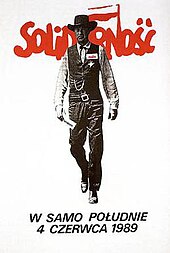
At the insistence of
Joseph Stalin, the
Yalta Conference sanctioned the formation of a new provisional pro-Communist coalition government in Moscow, which ignored the
Polish government-in-exile based in London; a move which angered many Poles who considered it a
betrayal by the Allies. In 1944, Stalin had made guarantees to
Churchill and
Roosevelt that he would maintain Poland's sovereignty and allow democratic elections to take place. However, upon achieving victory in 1945, the elections organized by the occupying Soviet authorities were falsified and were used to provide a veneer of 'legitimacy' for Soviet hegemony over Polish affairs. The Soviet Union instituted a new
communist government in Poland, analogous to much of the rest of the
Eastern Bloc.
As elsewhere in Communist Europe the Soviet occupation of Poland met with
armed resistance from the outset which continued into the fifties.
Despite widespread objections, the new Polish government accepted the Soviet annexation of the pre-war eastern regions of Poland
[70] (in particular the cities of
Wilno and
Lwów) and agreed to the permanent garrisoning of
Red Army units on Poland's territory. Military alignment within the
Warsaw Pact throughout the
Cold War came about as a direct result of this change in Poland's political culture and in the European scene came to characterise the full-fledged integration of Poland into the brotherhood of communist nations.
The
People's Republic of Poland (
Polska Rzeczpospolita Ludowa)
was officially proclaimed in 1952. In 1956 after the death of
Bolesław Bierut, the régime of
Władysław Gomułka became temporarily more liberal, freeing many people from prison and expanding some personal freedoms. A similar situation repeated itself in the 1970s under
Edward Gierek, but most of the time persecution of
anti-communist opposition groups persisted. Despite this, Poland was at the time considered to be one of the least oppressive states of the
Soviet Bloc.
[71]
Labour turmoil in 1980 led to the formation of the independent trade union "
Solidarity" ("
Solidarność"), which over time became a political force. Despite persecution and imposition of
martial law in 1981, it eroded the dominance of the
Polish United Workers' Party and by 1989 had triumphed in Poland's first
partially free and democratic parliamentary elections since the end of the Second World War.
Lech Wałęsa, a Solidarity candidate, eventually
won the presidency in 1990. The Solidarity movement heralded the
collapse of communist regimes and parties across Europe.
Present-day Poland

Flags of Poland and the
European Union; the country became a member of the community on 1 May 2004
A
shock therapy programme, initiated by
Leszek Balcerowicz in the early 1990s enabled the country to transform its socialist-style planned economy into a
market economy. As with all other post-communist countries, Poland suffered temporary slumps in social and economic standards, but it became the first post-communist country to reach its pre-1989 GDP levels, which it achieved by 1995 largely thanks to its booming economy.
[72][73]
Most visibly, there were numerous improvements in human rights, such as the
freedom of speech,
internet freedom (no censorship), civil liberties (1st class) and political rights (1st class), according to Freedom House. In 1991, Poland became a member of the
Visegrád Group and joined the
North Atlantic Treaty Organization (NATO) alliance in 1999 along with the
Czech Republic and
Hungary. Poles then voted to join the
European Union in
a referendum in June 2003, with Poland becoming a full member on 1 May 2004. Poland joined the
Schengen Area in 2007, as a result of which,
the country's borders with other member states of the European Union have been dismantled, allowing for
full freedom of movement within most of the EU.
[74] In contrast to this, a section of Poland's eastern border now comprises the external EU border with
Belarus, Russia and Ukraine. That border has become increasingly well protected, and has led in part to the coining of the phrase
'Fortress Europe', in reference to the seeming 'impossibility' of gaining entry to the EU for citizens of the
former Soviet Union.
Poland has been one of the most prominent voices of establishing a common
European Armed Forces, with Poland's
Premier along with
Chancellor Angela Merkel and
President Francois Hollande (collectively also part of
Weimar Triangle) taking steps to negotiate such a deal, in hope of drastically reducing dependence on
NATO and increasing readiness.
[75] Poland has already built several commands of a common battle group with
Hungary,
Czech Republic and
Slovakia, with a total of 12,000 troops ready for deployment. Poland is seeking to build more battle groups with
Lithuania and
Ukraine. These battle groups have vowed to serve under the European Union, and not NATO.
[76] Eurosceptics criticize such moves as further unnecessary integration and a new major step towards a federalized European Union under one government. Military integration is judged to be the most significant step after a monetary union.
[citation needed]
On 10 April 2010, the President of the Republic of Poland,
Lech Kaczyński, along with 89 other high-ranking Polish officials
died in a plane crash near
Smolensk, Russia. The president's party were on their way to attend an annual service of commemoration for the victims of the
Katyń massacre when the tragedy took place.
In 2011, the
Presidency of the Council of the European Union responsible for the functioning of the
Council was awarded to Poland. The same year
parliamentary elections took place to both
the Senate and the Sejm. They were won by the ruling Civic Platform. Poland joined
European Space Agency in 2012, as well as organised the
UEFA Euro 2012 (along with Ukraine). In 2013, Poland also became a member of the
Development Assistance Committee. In 2014 the
Prime Minister of Poland,
Donald Tusk, was elected
President of the European Council.
Geography

Poland's territory extends across several geographical regions, between latitudes
49° and
55° N, and longitudes
14° and
25° E. In the north-west is the Baltic seacoast, which extends from the
Bay of Pomerania to the
Gulf of Gdańsk. This coast is marked by several
spits, coastal lakes (former bays that have been cut off from the sea), and dunes. The largely straight coastline is indented by the
Szczecin Lagoon, the
Bay of Puck, and the
Vistula Lagoon. The centre and parts of the north lie within the
North European Plain.
Rising above these lowlands is a geographical region comprising the four hilly districts of
moraines and
moraine-dammed lakes formed during and after the
Pleistocene ice age. These lake districts are the
Pomeranian Lake District, the Greater Polish Lake District, the
Kashubian Lake District, and the
Masurian Lake District. The Masurian Lake District is the largest of the four and covers much of north-eastern Poland. The lake districts form part of the Baltic Ridge, a series of moraine belts along the southern shore of the
Baltic Sea.
South of the
Northern European Lowlands lie the regions of
Lusatia,
Silesia and
Masovia, which are marked by broad ice-age river valleys. Farther south lies the Polish mountain region, including the
Sudetes, the
Kraków-Częstochowa Upland, the
Świętokrzyskie Mountains, and the
Carpathian Mountains, including the
Beskids. The highest part of the Carpathians is the
Tatra Mountains, along Poland's southern border.
Geology
The geological structure of Poland has been shaped by the
continental collision of
Europe and
Africa over the past 60 million years, on the one hand (and the other), by the
Quaternary glaciations of northern Europe. Both processes shaped the
Sudetes and the
Carpathian Mountains. The moraine landscape of northern Poland contains soils made up mostly of sand or
loam, while the ice age
river valleys of the south often contain
loess. The Kraków-Częstochowa Upland, the
Pieniny, and the
Western Tatras consist of
limestone, while the
High Tatras, the
Beskids, and the
Karkonosze are made up mainly of
granite and
basalts. The
Polish Jura Chain is one of the oldest
mountain ranges on earth.
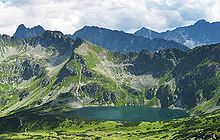
Tatra Mountains in southern Poland average 2,000 metres (6,600 ft) in elevation
Poland has 70 mountains over 2,000 metres (6,600 feet) in elevation, all in the
Tatras. The Polish Tatras, which consist of the High Tatras and the Western Tatras, is the highest mountain group of Poland and of the entire Carpathian range. In the High Tatras lies Poland's highest point, the north-western
summit of
Rysy, 2,499 metres (8,199 ft) in elevation. At its foot lies the mountain lakes of
Czarny Staw pod Rysami (Black Lake below Mount Rysy), and
Morskie Oko (the Marine Eye).
[77]
The second highest mountain group in Poland is the
Beskids, whose highest peak is
Babia Góra, at 1,725 metres (5,659 ft). The next highest mountain groups is the
Karkonosze in the
Sudetes, whose highest point is
Śnieżka, at 1,603 metres (5,259 ft);
Śnieżnik Mountains whose highest point is
Śnieżnik, at 1,425 metres (4,675 ft).
Tourists also frequent the
Bieszczady Mountains in the far southeast of Poland, whose highest point in Poland is
Tarnica, with an elevation of 1,346 metres (4,416 ft),
Gorce Mountains in
Gorce National Park, whose highest point is
Turbacz, with elevations 1,310 metres (4,298 ft), and the
Pieniny in
Pieniny National Park, whose highest point is Wysokie Skałki (Wysoka), with elevations 1,050 metres (3,445 ft). The lowest point in Poland – at 2 metres (6.6 ft) below sea level – is at Raczki Elbląskie, near
Elbląg in the Vistula Delta.

Shifting sand dunes in
Słowiński National Park located in northern Poland on the
Baltic Sea coast. Driven by wind, the dunes slowly move at an annual speed of 3 to 10 metres (9.8 to 32.8 ft) per year
The only
desert located in Poland stretches over the
Zagłębie Dąbrowskie (the Coal Fields of
Dąbrowa) region. It is called the
Błędów Desert, located in the
Silesian Voivodeship in southern Poland. It has a total area of 32 square kilometres (12 sq mi). It is one of only five natural
deserts in Europe. But also, it is the warmest desert that appears at this
latitude. Błędów Desert was created thousands of years ago by a
melting glacier. The specific geological structure has been of big importance. The average thickness of the sand layer is about 40 metres (131 ft), with a maximum of 70 metres (230 ft), which made the fast and deep
drainage very easy.
The Baltic Sea activity in
Słowiński National Park created
sand dunes which in the course of time separated
the bay from the sea. As waves and wind carry sand inland the dunes slowly move, at a speed of 3 to 10 metres (9.8 to 32.8 ft) meters per year. Some dunes are quite high – up to 30 metres (98 ft). The highest peak of the park – Rowokol (115 metres or 377 feet
above sea level) — is also an excellent
observation point.
Waters

A view of the
Vistula River near the
Royal Castle in
Sandomierz. The river is the longest in Poland, flowing the entire length of the country for 1,047 kilometres (651 mi) from south to north
The longest rivers are the
Vistula (
Polish:
Wisła), 1,047 kilometres (651 mi) long; the
Oder (
Polish:
Odra) which forms part of Poland's western border, 854 kilometres (531 mi) long; its tributary, the
Warta, 808 kilometres (502 mi) long; and the
Bug, a tributary of the Vistula, 772 kilometres (480 mi) long. The Vistula and the Oder flow into the Baltic Sea, as do numerous smaller rivers in Pomerania.
The
Łyna and the
Angrapa flow by way of the
Pregolya to the Baltic, and the
Czarna Hańcza flows into the Baltic through the
Neman. While the great majority of Poland's rivers drain into the Baltic Sea, Poland's Beskids are the source of some of the upper tributaries of the
Orava, which flows via the
Váh and the
Danube to the
Black Sea. The eastern Beskids are also the source of some streams that drain through the
Dniester to the Black Sea.
Poland's rivers have been used since early times for navigation. The
Vikings, for example, traveled up the Vistula and the Oder in their
longships. In the Middle Ages and in early modern times, when the Polish–Lithuanian Commonwealth was the breadbasket of Europe;
[78] the shipment of grain and other agricultural products down the Vistula toward
Gdańsk and onward to other parts of Europe took on great importance.
[78]
With almost ten thousand closed bodies of water covering more than 1 hectare (2.47 acres) each, Poland has one of the highest numbers of lakes in the world. In Europe, only
Finland has a greater density of lakes.
[79] The largest lakes, covering more than 100 square kilometres (39 sq mi), are
Lake Śniardwy and
Lake Mamry in
Masuria, and
Lake Łebsko and
Lake Drawsko in
Pomerania.
In addition to the lake districts in the north (in Masuria, Pomerania,
Kashubia, Lubuskie, and
Greater Poland), there is also a large number of mountain lakes in the Tatras, of which the Morskie Oko is the largest in area. The lake with the greatest depth—of more than 100 metres (328 ft)—is
Lake Hańcza in the Wigry Lake District, east of Masuria in
Podlaskie Voivodeship.
Among the first lakes whose shores were settled are those in the Greater Polish Lake District. The
stilt house settlement of
Biskupin, occupied by more than one thousand residents, was founded before the 7th century BC by people of the
Lusatian culture.
Lakes have always played an important role in Polish history and continue to be of great importance to today's modern Polish society. The ancestors of today's Poles, the
Polanie, built their first fortresses on islands in these lakes. The legendary Prince
Popiel ruled from
Kruszwica tower erected on the
Lake Gopło.
[80] The first historically documented ruler of Poland, Duke
Mieszko I, had his palace on an island in the Warta River in
Poznań. Nowadays the Polish lakes provide a location for the pursuit of water sports such as
yachting and
wind-surfing.
The Polish Baltic coast is approximately 528 kilometres (328 mi) long and extends from
Świnoujście on the islands of
Usedom and
Wolin in the west to
Krynica Morska on the
Vistula Spit in the east. For the most part, Poland has a smooth coastline, which has been shaped by the continual movement of sand by currents and winds. This continual
erosion and
deposition has formed cliffs, dunes, and spits, many of which have migrated landwards to close off former lagoons, such as Łebsko Lake in Słowiński National Park.

Baltic beaches of the
Gdańsk Bay are one of Poland's most popular tourist destinations.
[81] The Polish Baltic coast is approximately 528 kilometres (328 mi) long and extends from
Wolin island in the west to
Krynica Morska in the east
Prior to the end of the
Second World War and subsequent
change in national borders, Poland had only a very small coastline; this was situated at the end of the '
Polish Corridor', the only internationally recognised Polish territory which afforded the country access to the sea. However, after World War II, the redrawing of Poland's borders and resulting 'shift' of the country's borders left it with an expanded coastline, thus allowing for far greater access to the sea than was ever previously possible. The significance of this event, and importance of it to Poland's future as a major industrialised nation, was alluded to by the 1945
Wedding to the Sea.
The largest spits are
Hel Peninsula and the
Vistula Spit. The largest Polish Baltic island is
Wolin. The largest sea
harbours are
Szczecin,
Świnoujście,
Gdańsk,
Gdynia,
Police and
Kołobrzeg. The main coastal resorts are
Świnoujście,
Międzyzdroje,
Kołobrzeg,
Łeba,
Sopot,
Władysławowo and the Hel Peninsula.
Land use
Poland is the fourth most forested country in Europe. Forests cover about 30.5% of Poland's land area based on international standards.
[82] Its overall percentage is still increasing.
Forests of Poland is managed by the national program of reforestation (KPZL), aiming at an increase of forest-cover to 33% in 2050. The richness of Polish forest (per SoEF 2011 statistics) is more than twice as high as European average (with Germany and France at the top), containing 2.304 billion cubic metres of trees.
[82] The largest forest complex in Poland is
Lower Silesian Wilderness.
More than 1% of Poland's territory, 3,145 square kilometres (1,214 sq mi), is protected within 23
Polish national parks. Three more national parks are projected for
Masuria, the Kraków-Częstochowa Upland, and the eastern
Beskids. In addition,
wetlands along lakes and rivers in central Poland are legally protected, as are coastal areas in the north. There are over 120 areas designated as
landscape parks, along with numerous
nature reserves and other
protected areas (e.g.
Natura 2000).
Since Poland's accession to the European Union in 2004, Polish agriculture has performed extremely well and the country has over two million private farms.
[83][84] It is the leading producer in Europe of potatoes and
rye (world's second largest in 1989),
[51] the world's largest producer of
triticale,
[85] and one of the more important producers of barley, oats,
sugar beets, flax, and fruits.
[51] It is the European Union's fourth largest supplier of pigmeat after Germany, Spain and France.
[86] The government continues debating further agricultural reform and pursuing the option of auctioning off large tracts of state-owned agricultural land.
[51]
Biodiversity
Phytogeographically, Poland belongs to the Central European province of the
Circumboreal Region within the
Boreal Kingdom. According to the
World Wide Fund for Nature, the territory of
Poland belongs to three Palearctic Ecoregions of the continental forest spanning Central and Northern European
temperate broadleaf and mixed forest ecoregions as well as the Carpathian
montane conifer forest.
Many animals that have since died out in other parts of Europe still survive in Poland, such as the
wisent in the
ancient woodland of the
Białowieża Forest and in
Podlaskie. Other such species include the
brown bear in
Białowieża, in the Tatras, and in the Beskids, the
gray wolf and the
Eurasian lynx in various forests, the
moose in northern Poland, and the
beaver in Masuria, Pomerania, and Podlaskie.
In the forests, one also encounters game animals, such as
red deer,
roe deer and
wild boars. In eastern Poland there are a number of ancient woodlands, like
Białowieża forest, that have never been cleared by people. There are also large forested areas in the mountains, Masuria, Pomerania,
Lubusz Land and
Lower Silesia.

A family of
white storks. Poland is host to the largest white stork population in Europe
[87]
Poland is the most important breeding ground for a variety of European
migratory birds.
[88] Out of all of the migratory birds who come to Europe for the summer, one quarter of the global population of
White Storks (40,000 breeding pairs) live in Poland,
[89] particularly in the lake districts and the wetlands along the
Biebrza, the
Narew, and the
Warta, which are part of nature reserves or national parks.
Climate
The climate is mostly
temperate throughout the country. The climate is
oceanic in the north and west and becomes gradually warmer and
continental towards the south and east. Summers are generally warm, with average temperatures between 18 and 30 °C (64.4 and 86.0 °F) depending on a region. Winters are rather cold, with average temperatures around 3 °C (37.4 °F) in the northwest and −6 °C (21 °F) in the northeast.
Precipitation falls throughout the year, although, especially in the east; winter is drier than summer.
[90]
The warmest region in Poland is
Lower Silesia located in south-western Poland where temperatures in the summer average between 24 and 32 °C (75 and 90 °F) but can go as high as 34 to 39 °C (93.2 to 102.2 °F) on some days in the warmest month of July and August. The warmest cities in Poland are
Tarnów, which is situated in
Lesser Poland and
Wrocław, which is located in Lower Silesia. The average temperatures in Wrocław are 20 °C (68 °F) in the summer and 0 °C (32.0 °F) in the winter, but
Tarnów has the longest summer in all of Poland, which lasts for 115 days, from mid-May to mid-September. The coldest region of Poland is in the northeast in the
Podlaskie Voivodeship near the border of
Belarus and
Lithuania. Usually the coldest city is
Suwałki. The climate is affected by cold fronts which come from
Scandinavia and
Siberia. The average temperature in the winter in Podlaskie ranges from −6 to −4 °C (21 to 25 °F).
Politics

Poland is a democracy, with a
president as a
head of state, whose current
constitution dates from 1997. Poland is a
peaceful country. The government structure centers on the
Council of Ministers, led by a
prime minister. The president appoints the cabinet according to the proposals of the prime minister, typically from the majority coalition in the
Sejm. The president is elected by popular vote every five years. The president is
Bronisław Komorowski. Komorowski replaced President
Lech Kaczyński following the latter's death in an 10 April 2010
air crash. Since 2007 Polish government has been formed by the
Civic Platform party. The current prime minister,
Ewa Kopacz, was appointed in 2014.
Polish voters elect a
bicameral parliament consisting of a 460-member lower house (Sejm) and a 100-member Senate (
Senat). The Sejm is elected under
proportional representation according to the
d'Hondt method, a method similar to that used in many parliamentary political systems. The Senat, on the other hand, is elected under the
First-past-the-post voting method, with one senator being returned from each of the 100 constituencies.
With the exception of ethnic minority parties, only candidates of
political parties receiving at least 5% of the total national vote can enter the Sejm. When sitting in joint session, members of the Sejm and Senat form the
National Assembly (the
Zgromadzenie Narodowe). The National Assembly is formed on three occasions: when a new President takes the
oath of office; when an indictment against the President of the Republic is brought to the State Tribunal (
Trybunał Stanu); and when a president's permanent incapacity to exercise his duties due to the state of his health is declared. To date only the first instance has occurred.
The
judicial branch plays an important role in decision-making. Its major institutions include the
Supreme Court of the Republic of Poland (
Sąd Najwyższy); the
Supreme Administrative Court of the Republic of Poland (
Naczelny Sąd Administracyjny); the
Constitutional Tribunal of the Republic of Poland (
Trybunał Konstytucyjny); and the
State Tribunal of the Republic of Poland (
Trybunał Stanu). On the approval of the Senat, the Sejm also appoints the
ombudsman or the Commissioner for Civil Rights Protection (
Rzecznik Praw Obywatelskich) for a five-year term. The ombudsman has the duty of guarding the observance and implementation of the rights and liberties of Polish
citizens and
residents, of the law and of principles of community life and social justice.
Law
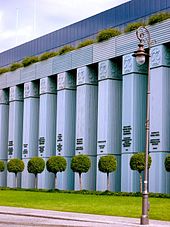
The
Constitution of Poland is the supreme law in contemporary Poland, and the Polish legal system is based on the principle of civil rights, governed by the code of Civil Law. Historically, the most famous Polish legal act is the
Constitution of 3 May 1791. Historian
Norman Davies describes it as the first of its kind in Europe.
[91] The Constitution was instituted as a
Government Act (
Polish:
Ustawa rządowa) and then adopted on 3 May 1791 by the
Sejm of the
Polish–Lithuanian Commonwealth. Primarily, it was designed to redress long-standing political defects of the
federative Polish–Lithuanian Commonwealth and its
Golden Liberty. Previously only the
Henrican articles signed by each of Poland's elected kings could perform the function of a set of basic laws.
The new Constitution introduced political equality between
townspeople and the
nobility (
szlachta), and placed the
peasants under the protection of the government. The Constitution abolished pernicious parliamentary institutions such as the
liberum veto, which at one time had placed the
sejm at the mercy of any deputy who might choose, or be
bribed by an interest or foreign power, to have rescinded all the legislation that had been passed by that sejm. The 3 May Constitution sought to supplant the existing anarchy fostered by some of the country's
reactionary magnates, with a more
egalitarian and democratic
constitutional monarchy. The adoption of
the constitution was treated as a threat by Poland's neighbours.
[92] In response
Prussia,
Austria and Russia formed an anti-Polish alliance and over the next decade collaborated with one another to
partition their weaker neighbour and destroyed the Polish state. In the words of two of its co-authors,
Ignacy Potocki and
Hugo Kołłątaj, the constitution represented "the last will and testament of the expiring Fatherland." Despite this, its text influenced many later
democratic movements across the globe.
[93] In Poland, freedom of expression is guaranteed by the Article 25 (section I. The Republic) and Article 54 (section II. The Freedoms, Rights and Obligations of Persons and Citizens) of the
Constitution of Poland.
Feminism in Poland started in 1800s in the age of the foreign Partitions. Poland's precursor of feminism,
Narcyza Żmichowska, founded a group of
Suffragettes in 1842. Prior to the
last Partition in 1795, tax-paying females were allowed to take part in political life. Since 1918, following the return to independence, all women could vote. Poland was the 15th (12th sovereign) country to introduce universal women's suffrage. Nevertheless, there is a number of issues concerning women in modern-day Poland such as the
abortion rights (formally allowed only in special circumstances) and the "
glass ceiling".
[94][95] Homosexuality in Poland was confirmed as legal in 1932. Poland recognises gender change.
[96] A
transgender Pole
Anna Grodzka has become a Member of Parliament (MP) in the
2011 parliamentary elections, and is the only transgender MP in the world presently,
[97] and one of the first ever in European history.
[98] Also in 2011,
Robert Biedroń was elected to the Sejm as its first openly gay member of parliament.
[99]
A 2010 article in
Rzeczpospolita reported that in a 2008 study three-quarters of Poles were against gay marriage or the adoption of children by gay couples in accordance with the Catholic teachings.
[100] The same study revealed that 66% of respondents were opposed to
Pride parade as the demonstration of a way of life, and 69% believed that gay people should not show their sexual orientation in public.
[101] Poland belongs to the group of 'Tier 1'
[102] countries in
Trafficking in Persons Report. Trafficking women is 'illegal and rare' (top results worldwide).
[103]
Poland's current constitution was adopted by the
National Assembly of Poland on 2 April 1997, approved by a national
referendum on 25 May 1997, and came into effect on 17 October 1997. It guarantees a multi-party state, the freedoms of religion, speech and assembly, and specifically casts off many Communist ideals to create a '
free market economic system'. It requires public officials to pursue ecologically sound public policy and acknowledges the inviolability of the home, the right to form trade unions, and to strike, whilst at the same time prohibiting the practices of forced medical experimentation,
torture and
corporal punishment.
Foreign relations
In recent years, Poland has extended its responsibilities and position in European and international affairs, supporting and establishing friendly relations with other European nations and a large number of 'developing' countries.
Poland is a member of the
European Union,
NATO, the
UN, the
World Trade Organization, the
Organisation for Economic Co-operation and Development (OECD),
European Economic Area,
International Energy Agency,
Council of Europe,
Organization for Security and Co-operation in Europe,
International Atomic Energy Agency,
European Space Agency,
G6,
Council of the Baltic Sea States,
Visegrád Group,
Weimar Triangle and
Schengen Agreement.
In 1994, Poland became an associate member of the European Union (EU) and its defensive arm, the
Western European Union (WEU), having submitted preliminary documentation for full membership in 1996, it formally joined the European Union in May 2004, along with the other members of the
Visegrád group. In 1996, Poland achieved full
OECD membership, and at the 1997 Madrid Summit was invited to join the
North Atlantic Treaty Organisation (NATO) in the first wave of
policy enlargement finally becoming a full member of NATO in March 1999.
As changes since the fall of Communism in 1989 have redrawn the map of Europe, Poland has tried to forge strong and mutually beneficial relationships with its seven new neighbours, this has notably included signing 'friendship treaties' to replace links severed by the collapse of the
Warsaw Pact. The Poles have forged special relationships with
Lithuania and particularly
Ukraine,
[104] with whom they co-hosted the UEFA
Euro 2012 football tournament, in an effort to firmly anchor these countries within the Western world and provide them with an alternative to aligning themselves with the
Russian Federation respectively. Despite many positive developments in the region, Poland has found itself in a position where it must seek to defend the rights of ethnic Poles living in the
former Soviet Union; this is particularly true of
Belarus, where in 2005 the
Lukashenko regime launched a campaign against the Polish ethnic minority.
[105]
Poland is the sixth most populous member state of the European Union and, ever since joining in 2004, has pursued policies to increase its role in European affairs. Poland has a grand total of 51 representatives in the
European Parliament and in addition to this, since 14 July 2009, former
Prime Minister of Poland Jerzy Buzek, has been
President of the European Parliament.
[106]
Administrative divisions
Poland's current
voivodeships (provinces) are largely based on the country's historic regions, whereas those of the past two decades (to 1998) had been centred on and named for individual cities. The new units range in area from less than 10,000 square kilometres (3,900 sq mi) for Opole Voivodeship to more than 35,000 square kilometres (14,000 sq mi) for Masovian Voivodeship. Administrative authority at voivodeship level is shared between a government-appointed
voivode (governor), an elected regional assembly (
sejmik) and an executive elected by that assembly.
The voivodeships are subdivided into
powiats (often referred to in English as counties), and these are further divided into
gminas (also known as communes or municipalities). Major cities normally have the status of both
gmina and
powiat. Poland has 16 voivodeships, 379 powiats (including 65 cities with
powiat status), and 2,478
gminas.
Military

The Polish armed forces are composed of four branches:
Land Forces (
Wojska Lądowe),
Navy (
Marynarka Wojenna),
Air Force (
Siły Powietrzne) and
Special Forces (
Wojska Specjalne). The military is subordinate to the
Minister for National Defence, however its sole commander in chief is the President of the Republic.
The Polish army consists of 65,000 active personnel, whilst the navy and air force respectively employ 14,300 and 26,126 servicemen and women. The Polish Navy is one of the larger navies on the Baltic Sea and is mostly involved in Baltic operations such as search and rescue provision for the section of the Baltic under Polish command, as well as hydrographic measurements and research; however, the Polish Navy played a more international role as part of the
2003 invasion of Iraq, providing logistical support for the
United States Navy. The current position of the Polish Air Force is much the same; it has routinely taken part in
Baltic Air Policing assignments, but otherwise, with the exception of a number of units serving in
Afghanistan, has seen no active combat since the end of the Second World War. In 2003, the
F-16C Block 52 was chosen as the new general multi-role fighter for the air force, the first deliveries taking place in November 2006; it is expected (2010) that the Polish Air Force will create three squadrons of F-16s, which will all be fully operational by 2012.
The most important mission of the armed forces is the defence of Polish territorial integrity and Polish interests abroad.
[107] Poland's national security goal is to further integrate with
NATO and European defence, economic, and political institutions through the modernisation and reorganisation of its military.
[107] The armed forces is being re-organised according to NATO standards, and as of 1 January 2010, the transition to an entirely contract-based military has been completed. During the previous period, men were obliged to undertake compulsory military service. In the final stage of validity of this type of military service (since 2007 until the amendment of the law on conscription in 2008) the duration of compulsory service amounted nine months.
[108]
Polish military doctrine reflects the same defensive nature as that of its NATO partners. From 1953 to 2009 Poland was a large contributor to various United Nations peacekeeping missions.
[107][109] The Polish Armed Forces took part in the
2003 invasion of Iraq, deploying 2,500 soldiers in the south of that country and commanding the 17-nation
Multinational force in Iraq.
The military was temporarily, but severely, affected by the loss of many of its top commanders in the wake the
2010 Polish Air Force Tu-154 crash near Smolensk, Russia, which killed all 96 passengers and crew, including, among others, the Chief of the Polish Army's General Staff
Franciszek Gągor and Polish Air Force commanding general
Andrzej Błasik. They were en route from Warsaw to attend an event to mark the 70th anniversary of the Katyn massacre, whose site is commemorated approximately 19 km (12 mi) west of
Smolensk.
[110][111]
Law enforcement and emergency services

Poland has a highly developed system of law enforcement with a long history of effective policing by the
State Police Service. The structure of law enforcement agencies within Poland is a multi-tier one, with the State Police providing criminal-investigative services,
Municipal Police serving to maintain public order and a number of other specialised agencies, such as the
Polish Border Guard, acting to fulfil their assigned missions. In addition to these state services, private security companies are also common, although they possess no powers assigned to state agencies, such as, for example, the power to make an arrest or detain a suspect.
Emergency services in Poland consist of the
Emergency Medical Services,
Search and Rescue units of the
Polish Armed Forces and
State Fire Service. Emergency medical services in Poland are, unlike other services, provided for by local and regional government.
Since joining the
European Union all of Poland's emergency services have been undergoing major restructuring and have, in the process, acquired large amounts of new equipment and staff.
[112] All emergency services personnel are now uniformed and can be easily recognised thanks to a number of innovative design features, such as reflective paint and printing, present throughout their service dress and vehicle liveries. In addition to this, in an effort to comply with EU standards and safety regulations, the police and other agencies have been steadily replacing and modernising their fleets of vehicles; this has left them with thousands of new automobiles, as well as many new aircraft, boats and helicopters.
[113]
Economy
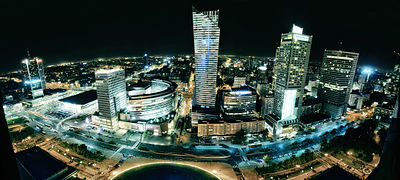
Warsaw is the financial and economic hub of Poland
Poland's high-income economy
[114] is considered to be one of the healthiest of the post-Communist countries and is one of the fastest growing within the EU.
[115] Having a strong domestic market, low private debt, flexible currency, and not being dependent on a single export sector, Poland is the only European economy to have avoided the
late-2000s recession.
[116][117] Since the
fall of the communist government, Poland has pursued a policy
of liberalising the economy. It is an example of the transition from a
centrally planned to a primarily
market-based economy. In 2009 Poland had the highest GDP growth in the EU - 1.6%.
[118][119][120] The country's most successful exports include machinery, furniture, foods and meats,
[121] motor boats, light planes, hardwood products, casual clothing, shoes and cosmetics.
[122] Germany is by far the biggest importer of Poland's exports as of 2013.
[123]
The
privatization of small and medium state-owned companies and a liberal law on establishing new firms have allowed the development of the private sector. As a consequence,
consumer rights organizations have also appeared. Restructuring and privatisation of "sensitive sectors" such as coal, steel, rail transport and energy has been continuing since 1990. Between 2007 and 2010, the government plans to float twenty public companies on the
Warsaw Stock Exchange, including parts of the coal industry. The biggest privatisations have been the sale of the national
telecoms firm
Telekomunikacja Polska to
France Télécom in 2000, and an issue of 30% of the shares in Poland's largest bank,
PKO Bank Polski, on the Polish stockmarket in 2004.
The Polish banking market is the largest in East Central and Eastern European region,
[124] with 32.3 branches per 100,000 adults.
[125][126] The banks are the largest and most developed sector of the country's
financial markets. They are regulated by the
Polish Financial Supervision Authority. During the transformation to a market-oriented economy, the government privatized some of them, recapitalized the rest, and introduced legal reforms that made the sector competitive. This has attracted a significant number of strategic foreign investors (ICFI). Poland's banking sector has approximately 5 national banks, a network of nearly 600 cooperative banks and 18 branches of foreign-owned banks. In addition, foreign investors have controlling stakes in nearly 40 commercial banks, which make up 68% of the banking capital.
[124]
Poland has a large number of private farms in its agricultural sector, with the potential to become a leading producer of food in the European Union. The biggest money-makers abroad include smoked and fresh fish, fine chocolate, and dairy products, meats and specialty breads,
[127] with the exchange rate conducive to export growth.
[128] Food exports amounted to 62 billion
zloty in 2011, increasing by 17% from 2010.
[129] Structural reforms in health care, education, the pension system, and state administration have resulted in larger-than-expected fiscal pressures. Warsaw leads Central Europe in foreign investment.
[citation needed] GDP growth had been strong and steady from 1993 to 2000 with only a short slowdown from 2001 to 2002.
The economy had growth of 3.7% annually in 2003, a rise from 1.4% annually in 2002. In 2004, GDP growth equaled 5.4%, in 2005 3.3% and in 2006 6.2%.
[130] According to
Eurostat data, Polish PPS GDP per capita stood at 67% of the EU average in 2012.
[131]
In terms of the clarity, efficiency and neutrality of Poland's legal framework for multinational investors, a 2012 report by the World Economic Forum concluded that the ongoing foreign business disputes may "have damaged Poland's reputation as an attractive location for
FDI" from other countries by creating the impression of "substandard reputation for maintaining an efficient and neutral framework to settle business disputes."
[132] Ernst and Young's 2010 European attractiveness survey reported that Poland saw a 52% decrease in FDI foreign job creation and a 42% decrease in number of FDI projects since 2008.
[133]
Average salaries in the enterprise sector in December 2010 were 3,848 PLN (1,012 euro or 1,374 US dollars)
[134] and growing sharply.
[135] Salaries vary between the regions: the
median wage in the capital city Warsaw was 4,603 PLN (1,177 euro or 1,680 US dollars) while in
Kielce it was 3,083 PLN (788 euro or 1125 US dollars). There is a wide distribution of salaries among the various districts of Poland. They range from 2,020 PLN (517 euro or 737 US dollars) in
Kępno County, which is located in
Greater Poland Voivodeship to 5,616 (1,436 euro or 2,050 US dollars) in
Lubin County, which lies in
Lower Silesian Voivodeship.
[136]
According to a
Credit Suisse report, Poles are the second wealthiest (after
Czechs) of the Central European peoples.
[137][138][139] Even though since World War II Poland is almost an ethnically homogeneous country, the number of foreign investors among immigrants is growing every year.
[139][140]
Since the opening of the labor market in the
European Union, Poland experienced a
mass emigration of over 2.3 million abroad, mainly due to higher wages offered abroad, and due to the raise in levels of
unemployment following the global
Great Recession of 2008.
[141][142][143] The out migration has increased the average wages for the workers who remained in Poland, in particular for those with intermediate level skills.
[144]
Commodities produced in Poland include: electronics, cars (
Arrinera,
Leopard), buses (
Autosan,
Solaris,
Solbus), helicopters (
PZL Świdnik), transport equipment, locomotives, planes (
PZL Mielec), ships, military engineering (including
tanks,
SPAAG systems), medicines (Polpharma, Polfa), food, clothes, glass, pottery (
Bolesławiec), chemical products and others.
Corporations
Poland is recognised as a regional economic power within East-Central Europe, with nearly 40 percent of the 500 biggest companies in the region (by revenues) as well as a
high globalisation rate.
[145] Poland was the only member of the EU to avoid the
recession of the late 2000s, a testament to the Polish economy's stability.
[116] The country's most competitive firms are components of the
WIG30 which is traded on the
Warsaw Stock Exchange.
Well known Polish brands include, among others,
PKO BP,
PKN Orlen,
PGE,
PZU,
PGNiG,
Tauron Group,
Lotos Group,
KGHM Polska Miedź,
Asseco,
Plus,
Play,
PLL LOT,
Poczta Polska,
PKP,
Biedronka, and
TVP.
[146]
Poland is recognised as having an economy with development potential, overtaking the
Netherlands in mid-2010 to become Europe's sixth largest economy.
[147] Foreign Direct Investment in Poland has remained steady ever since the country's re-democratisation following the
Round Table Agreement in 1989. However, problems still exist. It is believed that progress of privatization was uneven across sectors due to emergence of interest groups supporting government's push for the reforms based on
feasibility rather than
efficiency, at the cost of Poland's remaining sectors in need of development and modernisation, such as the extractive industries.
[148]
The list includes the largest companies by turnover in 2011, but does not include major banks or insurance companies:
Rank
2011
[149] |
Corporation |
Sector |
Headquarters |
Revenue
(Thou.
PLN) |
Profit
(Thou.
PLN) |
Employees |
| 1. |
PKN Orlen SA |
oil and gas |
Płock |
79 037 121 |
2 396 447 |
4,445 |
| 2. |
Lotos Group SA |
oil and gas |
Gdańsk |
29 258 539 |
584 878 |
5,168 |
| 3. |
PGE SA |
energy |
Warsaw |
28 111 354 |
6 165 394 |
44,317 |
| 4. |
Jerónimo Martins |
retail |
Kostrzyn |
25 285 407 |
N/A |
36,419 |
| 5. |
PGNiG SA |
oil and gas |
Warsaw |
23 003 534 |
1 711 787 |
33,071 |
| 6. |
Tauron Group SA |
energy |
Katowice |
20 755 222 |
1 565 936 |
26,710 |
| 7. |
KGHM Polska Miedź SA |
mining |
Lubin |
20 097 392 |
13 653 597 |
18,578 |
| 8. |
Metro Group Poland |
retail |
Warsaw |
17 200 000 |
N/A |
22,556 |
| 9. |
Fiat Auto Poland SA |
automotive |
Bielsko-Biała |
16 513 651 |
83 919 |
5,303 |
| 10. |
Orange Polska |
telecommunications |
Warsaw |
14 922 000 |
1 785 000 |
23,805 |
Tourism

Poland experienced an increase in the number of tourists after joining the European Union.
[150] Tourism in Poland contributes to the country's overall economy and makes up a relatively large proportion of the country's service market.
[151]
Kraków was the former capital and a relic of
Poland's Golden Age of Renaissance. It contains the
place of coronation of
most Polish kings. It was named a
European Capital of Culture by the European Union for the year 2000. The city of
Wrocław, designated as a European Capital of Culture in 2016,
[152] is one of the oldest in Poland. During
World War II, Wrocław was a fortress (Festung Breslau), and was heavily damaged in the nearly three months long
Siege of Breslau. The city has been restored and attracts several million tourists every year. The Poland's capital,
Warsaw went through
Old Town reconstruction after
its wartime destruction and it offers
a variety of attractions. Other cities include
Gdańsk,
Poznań,
Szczecin,
Lublin and
Toruń. There is the historic site of the
Auschwitz German concentration camp near
Oświęcim.

Table Mountains are a popular destination for hikers form across the country. The mountains are a 42 kilometre (26 mi) long range which forms part of the
Central Sudetes in south-western Poland
Poland's main tourist offerings include qualified tourism such as skiing, sailing and mountain hiking, as well as agrotourism, sightseeing walks, countryside excursions, as well as holiday and business trips. It is the 17th most visited country in the world by foreign tourists, as ranked by World Tourism Organization (
UNWTO) in 2012.
[153] Tourist destinations include
Baltic Sea coast in the north of Poland,
Masurian Lake District and
Białowieża Forest in the east, the northern
Karkonosze,
Table Mountains,
Tatra Mountains, in which has the highest peak of Polish (
Rysy) and the famous
Orla Perć;
Pieniny as well as
Bieszczady Mountains in the extreme south-east.
[154] There are
over 100 castles in the country, many along the popular
Trail of the Eagles' Nests.
[155]
Energy

The electricity generation sector in Poland is largely
fossil-fuel–based. Many power plants nationwide use Poland's position as a major European exporter of coal to their advantage by continuing to use coal as the primary raw material in production of their energy. In 2013 Poland scored 48 out of 129 states in the Energy Sustainability Index.
[156] The three largest Polish coal mining firms (
Węglokoks,
Kompania Węglowa and
JSW) extract around 100 million tonnes of coal annually. All three of these companies are key constituents of the
Warsaw Stock Exchange's lead economic indexes.
Renewable forms of energy account for a small
[quantify] proportion of Poland's full energy generation capacity.
[157] However, the national government has set targets for the development of renewable energy sources in Poland which should see the portion of power produced by renewable resources climb to 7.5% by 2010 and 15% by 2020. This is to be achieved mainly through the construction of
wind farms and a number of
hydroelectric stations.
Poland is thought to have around 164,800,000,000 m³ of proven natural gas reserves and around 96,380,000 barrels of proven oil reserves. These reserves are exploited by energy supply companies such as
PKN Orlen ("the only Polish company listed in the
Fortune Global 500"). However, the small amounts of fossil fuels naturally occurring in Poland is insufficient to satisfy the full energy consumption needs of the population. Therefore the country is a net importer of oil and natural gas.
Transport

Transport in Poland is provided by means of
rail,
road,
marine shipping and
air travel. Positioned in Central Europe with an eastern and a part of northeastern border compromising the longest land border of the
Schengen Area with the rest of
Northern and
Central Europe, Poland has long been, and remains a key country through which imports to the European Union and exports from it pass.
Since joining the EU in May 2004, Poland has invested large amounts of money into the modernisation of its transport networks. The country now has a developing expressways network composed of motorways such as the
A1,
A2,
A4,
A8,
A18 and express roads such as the
S1,
S3,
S5,
S7,
S8. In addition to these newly built roads, many local and regional roads are being rebuilt as part of a national programme to rebuild all roads in Poland.
[158]
Polish authorities maintain a program of improving operating speeds across the entire Polish rail network. Polish State Railways (PKP) are using new rolling stock, such as Siemens Taurus ES64U4 capable theoretically of speed equal 200 km/h (124 mph). As of December 2014 Poland began implementing
high–speed rail connecting major Polish cities. The Polish government has revealed that it intends to connect all major cities to a future high-speed rail network by 2020.
[159] PKP Pendolino ETR 610 new test train set the record for the fastest train in the history of Poland, reaching 293 kilometres per hour (182 mph) on 24 November 2013. Old top speed was 160 kilometres per hour (99 mph) since 1985. Most intercity rail operations in Poland are operated by
PKP Intercity whilst regional trains are run by a number of operators, the largest of which is
Przewozy Regionalne.
On 14 December 2014, Polish State Railways started passenger service using the PKP Pendolino ED250, operating at 200 km/h speed on 80 km of line between Olszamowice and Zawiercie (part of the
Central Rail Line from Warsaw to Kraków). Currently it is the line with highest railway speed in Poland. Poland is the first country from the 2004 enlargement of the European Union which has started to offer passenger rail services with scheduled traffic over 160 km/h.

LOT Polish Airlines is the world's 12th oldest air carrier still in operation, originally established on 1 January 1929
The air and maritime transport markets in Poland are largely well developed. Poland has a number of international airports; the largest of which is
Warsaw Chopin Airport, the primary global hub for
LOT Polish Airlines. LOT is 28th
largest European airline and the world's 12th
oldest still in operation, established in 1929, from a merge of
Aerolloyd (1922) and
Aero (1925). Other major airports with international connections in almost every region are for example
John Paul II International Airport Kraków–Balice and
Wrocław–Copernicus Airport.
Seaports exist all along Poland's Baltic coast, with most freight operations using
Szczecin,
Świnoujście,
Gdynia and
Gdańsk as well as
Police,
Kołobrzeg and
Elbląg as their base. Passenger ferries link Poland with
Scandinavia all year round; these services are provided from Gdańsk and
Świnoujście by
Polferries,
Stena Line from Gdynia and
Unity Line from the
Port of Świnoujście.
Science and technology

According to Frost & Sullivan's Country Industry Forecast the country is becoming an interesting location for
research and development investments.
[160] Multinational companies such as: ABB,
Delphi,
GlaxoSmithKline,
Google,
Hewlett–Packard,
IBM,
Intel,
LG Electronics,
Microsoft,
Motorola,
Siemens and
Samsung have set up research and development centres in Poland.
[161] Over 40 research and development centers and 4,500 researchers make Poland the biggest research and development hub in Central and Eastern Europe.
[160][162] Companies chose Poland because of the availability of highly qualified labour force, presence of universities, support of authorities, and the largest market in East-Central Europe.
[160]
Today Poland's tertiary education institutions; traditional
universities (found in its major cities), as well as technical, medical, and economic institutions, employ around 61,000 researchers and members of staff. There are around 300 research and development institutes, with about 10,000 researchers. In total, there are around 91,000 scientists in Poland today. However, in the 19th and 20th centuries many Polish scientists worked abroad; one of the most important of these exiles was
Maria Skłodowska-Curie, a physicist and chemist who lived much of her life in France. In the first half of the 20th century, Poland was a flourishing centre of mathematics. Outstanding Polish mathematicians formed the
Lwów School of Mathematics (with
Stefan Banach,
Hugo Steinhaus,
Stanisław Ulam) and
Warsaw School of Mathematics (with
Alfred Tarski,
Kazimierz Kuratowski,
Wacław Sierpiński). The events of
World War II pushed many of them into exile. Such was the case of
Benoît Mandelbrot, whose family left Poland when he was still a child. An alumnus of the Warsaw School of Mathematics was
Antoni Zygmund, one of the shapers of 20th-century
mathematical analysis.
According to a KPMG report
[164] 80% of Poland's current investors are content with their choice and willing to reinvest. In 2006, Intel decided to double the number of employees in its research and development centre in Gdańsk.
[161]
Communications

The share of the telecom sector in the GDP is 4.4% (end of 2000 figure), compared to 2.5% in 1996. The coverage increased from 78 users per 1,000 inhabitants in 1989 to 282 in 2000. The value of the telecommunication market is zl 38.2bn (2006), and it grew by 12.4% in 2007 PMR.
[165] The coverage mobile cellular is over 1000 users per 1000 people (2007). Telephones—mobile cellular: 38.7 million (Onet.pl & GUS Report, 2007), telephones—main lines in use: 12.5 million (Telecom Team Report, 2005).
With regard to internet access, the most popular
ADSL services for home users in Poland are
Neostrada provided by
TPSA, and Net24 provided by
Netia. Business users as well as some home users use Internet DSL TP also offered by TPSA. According to Eurostat, OECD and others, Internet access in Poland is amidst the most expensive in Europe. This is mostly caused by the lack of competitiveness. New operators, such as Dialog and GTS Energis are making their own provider lines and offer more attractive and cheaper service. The Polish Office of Electronical Communication is forcing the TPSA to rent 51% of their ADSL lines to other ISPs for 60% lower prices. This move will affect the prices of DSL in Poland. In 2012, the process of converting to
Digital terrestrial television started, to be compatible with the rest of Europe.
[citation needed]
The public postal service in Poland is operated by
Poczta Polska (the Polish Post). It was created on 18 October 1558, when King
Zygmunt August established a permanent postal route from
Kraków to
Venice. The service was dissolved during the foreign partitions. After regaining independence in 1918, Poland saw the rapid development of the postal system as new services were introduced including
money transfers, payment of pensions, delivery of magazines, and
air mail. During
wars and national uprisings communication was provided mainly through the military authorities. Many important events in the history of Poland involved the postal service, like the heroic
defence of the Polish Post Office in Gdańsk in 1939, and the participation of the Polish Scouts' Postal Service in the
Warsaw Uprising. Nowadays the service is a modern state-owned company that provides a number of standard and express delivery as well as home-delivery services. Digital technologies are made available through the Internet platform
Envelo.
[166][167]
Demographics

Population of Poland, 1961-2010; data of
FAO, number of inhabitants in millions
Poland, with 38,544,513 inhabitants, has the eighth-largest population in Europe and the sixth-largest in the
European Union. It has a population density of 122 inhabitants per square kilometer (328 per square mile).
Poland historically contained
many languages, cultures and religions on its soil. The country had a particularly large Jewish population prior to
World War II, when the
Nazi Germany's regime led to
The Holocaust. There were an estimated 3 million Jews before the war; 300,000 after. The outcome of the war, particularly the
shift of Poland's borders to the area between the
Curzon Line and the
Oder-Neisse line, coupled with post-war
expulsion of minorities, significantly reduced the country's ethnic diversity. Over 7 million Germans fled or were expelled from the Polish side of the Oder-Neisse boundary.
[168]
According to the
2002 census, 36,983,700 people, or 96.74% of the population, consider themselves
Polish, while 471,500 (1.23%) declared another nationality, and 774,900 (2.03%) did not declare any nationality. The largest minority nationalities and ethnic groups in Poland are
Silesians (173,153 according to the census),
Germans (152,897 according to the census, 92% of whom live in
Opole Voivodeship and
Silesian Voivodeship),
Belarusians (c. 49,000),
Ukrainians (c. 30,000),
Lithuanians,
Russians,
Roma,
Jews,
Lemkos,
Slovaks,
Czechs, and
Lipka Tatars.
[169] Among foreign citizens, the
Vietnamese are the largest ethnic group, followed by
Greeks and
Armenians.
The
Polish language, part of the
West Slavic branch of the
Slavic languages, functions as the
official language of Poland. Until recent decades Russian was commonly learned as a second language but has been replaced by English and German as the most common second languages studied and spoken.
[170]
In recent years, Poland's population has decreased due to an increase in emigration and a sharp decline in the birth rate. Since Poland's accession to the European Union, a significant number of Poles have emigrated, primarily to the United Kingdom, Germany and Republic of Ireland in search of better work opportunities abroad.
[171]
Polish minorities are still present in the neighboring countries of Ukraine, Belarus, and Lithuania, as well as in other countries (see
Poles for population numbers). Altogether, the number of ethnic Poles living abroad is estimated to be around 20 million.
[172] The largest number of
Poles outside of Poland can be found in the
United States.
[173]
The
total fertility rate (TFR) in Poland was estimated in 2013 at 1.32 children born/woman, which is below the replacement rate of 2.1.
[174]
Urbanization
|
|
Rank |
Name |
Voivodeship |
Pop. |
Rank |
Name |
Voivodeship |
Pop. |
|

Warsaw

Kraków |
1 |
Warsaw |
Masovian |
1,715,518 |
11 |
Białystok |
Podlaskie |
294,921 |

Łódź

Wrocław |
| 2 |
Kraków |
Lesser Poland |
760,700 |
12 |
Gdynia |
Pomeranian |
248,726 |
| 3 |
Łódź |
Łódź |
718,960 |
13 |
Częstochowa |
Silesian |
234,472 |
| 4 |
Wrocław |
Lower Silesian |
631,188 |
14 |
Radom |
Masovian |
219,703 |
| 5 |
Poznań |
Greater Poland |
550,742 |
15 |
Sosnowiec |
Silesian |
213,513 |
| 6 |
Gdańsk |
Pomeranian |
460,427 |
16 |
Toruń |
Kuyavian-Pomeranian |
204 299 |
| 7 |
Szczecin |
West Pomeranian |
408,913 |
17 |
Kielce |
Świętokrzyskie |
200,938 |
| 8 |
Bydgoszcz |
Kuyavian-Pomeranian |
361,254 |
18 |
Gliwice |
Silesian |
186,210 |
| 9 |
Lublin |
Lublin |
347,678 |
19 |
Rzeszów |
Subcarpathian |
182,028 |
| 10 |
Katowice |
Silesian |
307,233 |
20 |
Zabrze |
Silesian |
179,452 |
Languages

Dolina Jadwigi — a
bilingual (Polish-Kashubian) road sign with the village name

The oldest printed text in the
Polish language –
Statuta Synodalia Episcoporum Wratislaviensis printed in 1475 in
Wrocław by Kasper Elyan
Polish
Polish (
język polski,
polszczyzna) is a
Slavic language spoken primarily in Poland and the
native language of the
Poles. It belongs to the
Lechitic subgroup of
West Slavic languages.
[175] Polish is the
official language of Poland, but it is also used throughout the world by
Polish minorities in other countries. It is one of the official
languages of the European Union. Its written standard is the
Polish alphabet, which has 9 additions to the letters of the basic
Latin script (
ą,
ć,
ę,
ł,
ń,
ó,
ś,
ź,
ż).
Sign language
The deaf communities use
Polish Sign Language belonging to the
German family of Sign Languages.
Minority languages
According to the
Act of 6 January 2005 on national and ethnic minorities and on the regional languages,
[176] 16 other languages have officially recognized status of minority languages: 1 regional language, 10 languages of 9 national minorities (the minorities that have their own independent state elsewhere) and 5 languages of 4 ethnic minorities spoken by the members of minorities not having a separate state elsewhere). Jewish and Romani minorities each have 2 minority languages recognized.
Languages having the status of national minority's language
Languages having the status of ethnic minority's language
The official recognition gives to the representatives of the minority certain rights (under certain conditions prescribed by the laws): of education in their language, of having the language established as the secondary administrative language or help language in their
municipalities, of financial support of the state to the promotion of their language and culture etc.
Religion
Religion in Poland according to 2011 survey of 91,2% of citizens
Opting out of answer (7.1%)
Non believer (2.4%)
Not stated (1.6%)
Other religions (1%)
From its beginnings, Poland has contributed substantially to the development of religious freedom. Since the country adopted Christianity in 966, it was also welcoming to other religions through a series of laws:
Statute of Kalisz (1264),
Warsaw Confederation (1573). However, the Polish king
Władysław II Jagiełło was pressed by the Catholic Church to issue the
Edict of Wieluń (1424), outlawing early Protestant
Hussitism. Polish theological thought include theological movements, such as Calvinist
Polish Brethren and a number of other Protestant groups, as well as atheists, such as ex-Jesuit philosopher
Kazimierz Łyszczyński, one of the first atheist thinkers in Europe.
Until
World War II Poland was a religiously diverse society, in which substantial
Jewish,
Christian Orthodox,
Protestant and Roman Catholic groups coexisted.
[178] In the Second Polish Republic, Roman Catholic was the dominant religion, declared by about 65% of the Polish citizens, followed by other Christian denominations, and about 3% of Judaism believers.
[179] As a result of the
Holocaust and the post–World War II
flight and expulsion of German and
Ukrainian populations, Poland has become overwhelmingly Roman Catholic. In 2007, 88.4% of the population belonged to the Catholic Church.
[180] Though rates of religious observance are lower, at 52%
[181] or 51% of the Polish Catholics,
[182] Poland remains one of the most devoutly religious countries in Europe.
[183]
From 16 October 1978 until his death on 2 April 2005 Karol Józef Wojtyła (later Pope
John Paul II), a Polish native, reigned as
Supreme Pontiff of the Roman Catholic Church. He has been the only
Slavic and
Polish Pope to date, and was the first non-Italian Pope since
Dutch Pope Adrian VI in 1522.
[184] Additionally he is credited with having played a significant role in hastening the downfall of communism in Poland and throughout
Central and Eastern Europe; he is famously quoted as having, at the height of communism in 1979, told Poles "not be afraid", later praying: "Let your Spirit descend and change the image of the land... this land".
[185][186]
Religious minorities include
Polish Orthodox (about 506,800),
[8] various Protestants (about 150,000),
[8] Jehovah's Witnesses (126,827),
[8] Eastern Catholics,
Mariavites,
Polish Catholics,
Jews, and
Muslims (including the
Tatars of
Białystok). Members of Protestant churches include about 77,500 in the largest
Evangelical-Augsburg Church,
[8] and a similar number in smaller
Pentecostal and
Evangelical churches. There are also a few thousand pagans some of whom are members of such officially registered churches as the
Native Polish Church, (Rodzimy Kościół Polski).
Freedom of religion is now guaranteed by the 1989 statute of the Polish Constitution,
[187] enabling the emergence of additional denominations.
[188] The
Concordat between the
Holy See and Poland guarantees the teaching of religion in state
[189] schools. According to a 2007 survey, 72% of respondents were not opposed to
religious instruction in public schools; alternative courses in ethics are available only in one percent of the entire public educational system.
[190]
Famous sites of Christian pilgrimage in Poland include the
Monastery of Jasna Góra in the southern Polish city of
Częstochowa, as well as the
Family home of John Paul II in
Wadowice just outside of
Kraków.
Health

Poland's healthcare system is based on an all-inclusive insurance system. State subsidised healthcare is available to all Polish citizens who are covered by this general health insurance program. However, it is not compulsory to be treated in a state-run hospital as a number of private medical complexes do exist nationwide.
[191]
All medical service providers and hospitals in Poland are subordinate to the
Polish Ministry of Health, which provides oversight and scrutiny of general medical practice as well as being responsible for the day-to-day administration of the healthcare system. In addition to these roles, the ministry is also tasked with the maintenance of standards of hygiene and patient-care.
Hospitals in Poland are organised according to the regional administrative structure, resultantly most towns have their own hospital
(Szpital Miejski).
[citation needed] Larger and more specialised medical complexes tend only to be found in larger cities, with some even more specialised units located only in the capital,
Warsaw. However, all
voivodeships have their own general hospital (most have more than one), all of which are obliged to have a trauma centre; these types of hospital, which are able to deal with almost all medical problems are called 'regional hospitals'
(Szpital Wojewódzki). The last category of hospital in Poland is that of specialised medical centres, an example of which would be the
Skłodowska-Curie Institute of Oncology, Poland's leading, and most highly specialised centre for the research and treatment of cancer.
In 2012, the Polish health-care industry experienced a transformation. Hospitals were given priority for refurbishment where necessary.
[192] As a result of this process, many hospitals were updated with the latest medical equipment.
In 2013, the average
life expectancy at birth was 76.45 years (72.53 years infant male/80.62 years infant female).
[193]
Education

The wearing of traditional
academic dress is an important and traditional feature of Polish educational ceremonies
The
Commission of National Education (
Komisja Edukacji Narodowej) established in 1773, was the world's first state ministry of education.
[194][195] The education of Polish society was a goal of rulers as early as the 12th century. Poland became one of the most educated countries in Europe. The library catalogue of the
Cathedral Chapter of Kraków dating back to 1110 shows that in the early 12th-century Polish intellectuals had access to European literature. The
Jagiellonian University, founded in 1364 by
King Casimir III in Kraków was blessed by
Pope Urban V. It is
the world's 19th oldest university.
The modern-day
Programme for International Student Assessment, coordinated by the
Organisation for Economic Co-operation and Development, ranks Poland's educational system in its
PISA 2012 as the 10th best in the world,
[196] scoring higher than the OECD average.
[197]
Elementary and secondary
Education in Poland starts at the age of five or six (with the particular age chosen by the parents) for the '0' class (Kindergarten) and six or seven years in the 1st class of primary school (
Polish szkoła podstawowa). It is compulsory that children participate in one year of formal education before entering the 1st class at no later than 7 years of age.
Corporal punishment of children in
schools is officially prohibited since 1783 (before the partitions) and criminalised since 2010 (in schools as well as at home).
[47]

Density of collegiate-level institutions of higher education
At the end of the 6th class when students are 13, students take a compulsory exam that will determine their acceptance and transition into a specific lower secondary school (
gimnazjum, pronounced gheem-nah-sium) (Middle School/Junior High). They will attend this school for three years during classes 7, 8, and 9. Students then take another compulsory exam to determine the upper secondary level school they will attend. There are several alternatives, the most common being the three years in a
liceum or four years in a
technikum. Both end with a maturity examination (
matura, quite similar to French
baccalauréat), and may be followed by several forms of upper education, leading to
licencjat or inżynier (the Polish
Bologna Process first cycle qualification),
magister (second cycle qualification) and eventually
doktor (third cycle qualification).
[198]
Higher education
There are 500 university-level institutions for the pursuit of higher education in Poland,
[199] one of the largest number in Europe. The
Jagiellonian University in Kraków, the first Polish university, was founded in 1364 by King
Casimir III, as the 19th
oldest university in the world, established in 1364.
There are 18 fully accredited traditional universities in Poland. There are twenty technical universities, nine independent medical universities, five universities for the study of economics, nine agricultural academies, three pedagogical universities, a theological academy and three maritime service universities.
There are a number of higher educational institutions dedicated to the teaching of the arts. Amongst these are the seven higher state academies of music. There are a number of private educational institutions and four national military academies (two for the army and one each for the other branches of service).
Culture

The culture of Poland is closely connected with its intricate 1,000-year
history[202] Its unique character developed as a result of its geography at the confluence of European cultures. With origins in the culture of the
Proto-Slavs, over time Polish culture has been profoundly influenced by its interweaving ties with the
Germanic,
Latinate and
Byzantine worlds as well as in continual dialog with the many other ethnic groups and minorities living in Poland.
[203] The people of Poland have traditionally been seen as hospitable to artists from abroad and eager to follow cultural and artistic trends popular in other countries. In the 19th and 20th centuries the Polish focus on cultural advancement often took precedence over political and economic activity. These factors have contributed to the versatile nature of Polish art, with all its complex nuances.
[203]
Famous people
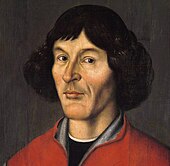
Mikołaj Kopernik the 16th century Polish astronomer who formulated the
heliocentric model of the solar system that placed the Sun rather than the Earth at its center; first published in 1543
The
list of famous Poles begins in earnest with the polymath
Mikołaj Kopernik,
[204] who studied at the
Jagiellonian University founded in 1364 by Casimir the Great from proceeds of his
Wieliczka Salt Mine.
[205] Poland is the birthplace of many distinguished personalities among whom are:
Fryderyk Chopin,
[206][207] Maria Skłodowska Curie,
[208] Tadeusz Kościuszko,
Kazimierz Pułaski,
Józef Piłsudski,
Lech Wałęsa and
Pope John Paul II (Karol Wojtyła). Great Polish painter
Jan Matejko devoted his monumental art to the most significant historical events on Polish lands, along with the playwright, painter and poet
Stanisław Wyspiański.
Stanisław Ignacy Witkiewicz (Witkacy) was an example of a Polish avant-garde philosopher and author of aesthetic theories. Polish
Joseph Conrad was a notable author of works in English.
[209] Many world famous
Polish movie directors include
Academy Awards winners
Roman Polański,
Andrzej Wajda,
Zbigniew Rybczyński,
Janusz Kamiński,
Krzysztof Kieślowski, and
Agnieszka Holland. Actresses known outside of Poland, include
Helena Modjeska and
Pola Negri.
Society
Poland has a long-standing tradition of tolerance towards minorities, as well as an absence of discrimination on the grounds of religion, nationality or race.
[210] Prior to World War II, ethnic minorities made up a significant proportion of the Polish population. Poland has maintained a high level of
gender equality, an established
disability rights movement and promotes peaceful equality.
[citation needed]

John Paul II was the first
Pole and
Slav to become a
Roman Catholic Pope, and is considered to have been a great promoter of Poland around the world. He held the Pope position between 1978-2005
Poland was the first country in the world to prohibit
corporal punishment in all its forms.
[47] Poland has, throughout most of its long history, experienced only very limited immigration from abroad; this trend can be largely attributed to Poland's rejection of slavery and to a lack of overseas colonies as well as occupation of its territories during much of the 19th and early 20th centuries. Despite this, the country has for a long time been regarded as having a very tolerant society, which affords equal rights to all people no matter what their ethnic background.
[citation needed] This can be said to stem largely from the reign of King
Casimir III the Great and his acceptance for Poland's
Jewish community, in a time when most of Europe recessed into
antisemitic moods and actions. The
history of Jews in Poland exemplifies peaceful co-existence of a nation with a particular
ethnic group.
Today, as many as 96.7% of Polish citizens declare to be
Poles, and 97.8% declare that they speak
Polish at home (Census 2002). The population of Poland became one of the most ethnically homogeneous in the world as a result of the radically altered borders after
World War II and the subsequent migrations. This homogeneity is a result of post World War II deportations ordered by the Soviet authorities, who wished to remove the sizeable Polish minorities from Lithuania, Belarus and Ukraine and
repatriation of Ukrainians from Poland to the Soviet Union (see
territorial changes of Poland and
historical demography of Poland for details). Unlike in many other countries, the ethnic
minority rights in Poland are guaranteed directly by the
Constitution of Poland (art. 35), and today there are, among others, sizeable
German,
Ukrainian and
Belarusian minorities in the country.
[211]
In 2013, the
Polish parliament rejected
proposed legislation for civil partnerships, which the majority of Polish society is against,
[212] but for the first time it gave an asylum to a gay person from Uganda on the basis of the sexual orientation.
[213] In a 2013 opinion poll conducted by
CBOS, 60% of Poles were against homosexual civil partnerships, 72% were against
same-sex marriage, 88% were against adoption by same-sex couples, and 68% were against gays and lesbians publicly showing their way of life.
[212] Article 18 of the
Constitution of Poland bans same-sex marriage.
[214]
The results of an
Organization for Security and Co-operation in Europe (OSCE) survey from 2004 showed that Poles worked the second most hours per week of any nationality worldwide. Poland remains one of the most peaceful countries in the world.
[215]
Music
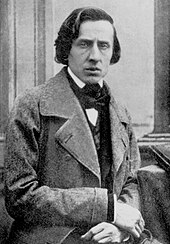
Artists from Poland, including famous composers like
Chopin or
Penderecki and traditional, regionalized
folk musicians, create a lively and diverse music scene, which even recognizes its own
music genres, such as
poezja śpiewana and
disco polo. As of 2006, Poland is one of the few countries in Europe where
rock and
hip hop dominate over pop music, while all kinds of
alternative music genres are encouraged.
[citation needed]
The origins of Polish music can be traced as far back as the 13th century; manuscripts have been found in
Stary Sącz, containing
polyphonic compositions related to the Parisian
Notre Dame School. Other early compositions, such as the melody of
Bogurodzica and
Bóg się rodzi (a coronation polonaise for Polish kings by an unknown composer), may also date back to this period, however, the first known notable composer,
Mikołaj z Radomia, was born and lived in the 15th century. During the 16th century, two main musical groups – both based in
Kraków and belonging to the King and Archbishop of the Wawel – led to the rapid development of Polish music. Composers writing during this period include
Wacław z Szamotuł,
Mikołaj Zieleński, and
Mikołaj Gomółka.
Diomedes Cato, a native-born Italian who lived in Kraków from about the age of five, became a renown lutenists at the court of Sigismund III, and not only imported some of the musical styles from southern Europe, but blended them with native folk music.
[216]
At the end of the 18th century, Polish classical music evolved into national forms like the
polonaise. In the 19th century the most popular composers were:
Józef Elsner and his pupils
Fryderyk Chopin and Ignacy Dobrzyński. Important opera composers of the era were
Karol Kurpiński and
Stanisław Moniuszko whilst the list of famous soloists and composers included
Henryk Wieniawski,
Juliusz Zarębski. At the turn of the 19th and 20th centuries the most prominent composers could said to have been
Władysław Zeleński and
Mieczysław Karłowicz, with
Karol Szymanowski gaining prominence prior to World War II.
Alexandre Tansman lived in Paris but had strong connections with Poland.
Witold Lutosławski,
Henryk Górecki, and
Krzysztof Penderecki composed in Poland,
Andrzej Panufnik emigrated.
Traditional Polish folk music has had a major effect on the works of many well-known Polish composers, and no more so than on Fryderyk Chopin, a widely recognised national hero of the arts. All of Chopin's
works involve the piano and are technically demanding, emphasising nuance and expressive depth. As a great composer, Chopin invented the
musical form known as the
instrumental ballade and made major innovations to the
piano sonata,
mazurka,
waltz,
nocturne,
polonaise,
étude,
impromptu and
prélude, he was also the composer of a number of polonaises which borrowed heavily from traditional Polish folk music. It is largely thanks to him that the such pieces gained great popularity throughout Europe during the 19th century. Nowadays the most distinctive folk music can be heard in the towns and villages of the mountainous south, particularly in the region surrounding the winter resort town of
Zakopane.
Today Poland has a very active music scene, with the jazz and metal genres being particularly popular among the contemporary populace. Polish jazz musicians such as
Krzysztof Komeda, created a unique style, which was most famous in 1960s and 1970s and continues to be popular to this day. Since the fall of Communism, Poland has become a major venue for large-scale music festivals, chief among which are the
Open'er Festival,
Opole Festival and
Sopot Festival.
Visual arts

Polish art has always reflected European trends while maintaining its unique character. The
Kraków school of Historicist painting developed by
Jan Matejko produced monumental portrayals of customs and significant events in Polish history.
Stanisław Witkiewicz was an ardent supporter of
Realism in Polish art, its main representative being
Jozef Chełmoński. The Młoda Polska (
Young Poland) movement witnessed the birth of modern Polish art, and engaged in a great deal of formal experimentation led by
Jacek Malczewski (
Symbolism),
Stanisław Wyspiański,
Józef Mehoffer, and a group of Polish
Impressionists. Artists of the twentieth-century Avant-Garde represented various schools and trends. The art of
Tadeusz Makowski was influenced by
Cubism; while
Władysław Strzemiński and
Henryk Stażewski worked within the Constructivist idiom. Distinguished contemporary artists include
Roman Opałka, Leon Tarasewicz,
Jerzy Nowosielski,
Wojciech Siudmak,
Mirosław Bałka, and
Katarzyna Kozyra and Zbigniew Wąsiel in the younger generation. The most celebrated Polish sculptors include
Xawery Dunikowski,
Katarzyna Kobro,
Alina Szapocznikow and
Magdalena Abakanowicz. Since the inter-war years, Polish art and documentary photography has enjoyed worldwide recognition. In the sixties the Polish Poster School was formed, with
Henryk Tomaszewski and
Waldemar Świerzy at its head.
[203] Top fine Art schools in Poland are
Jan Matejko Academy of Fine Arts,
Cracow School of Art and Fashion Design,
Academy of Fine Arts in Warsaw,
Art Academy of Szczecin,
University of Fine Arts in Poznań and
Eugeniusz Geppert Academy of Fine Arts.
Architecture

Polish cities and towns reflect the whole spectrum of European styles.
Romanesque architecture is represented by
St. Andrew's Church, Kraków, and characteristic for Poland
Brick Gothic by
St. Mary's Church, Gdańsk. Richly decorated
attics and
arcade loggias are the common elements of the Polish Renaissance architecture,
[218][219] like in
City Hall in Poznań. For some time the late renaissance, so called
mannerism, most notably in
Bishop's Palace in
Kielce, coexisted with the early baroque like in Church of SS. Peter and Paul in Kraków.
History has not been kind to Poland's architectural monuments. Nonetheless, a number of ancient structures had survived: castles, churches, and stately buildings, often unique in the regional or European context. Some of them have been painstakingly restored, like
Wawel Castle, or completely reconstructed after being destroyed in the
Second World War, including the
Old Town and
Royal Castle in Warsaw and the Old Town of
Gdańsk.
The architecture of Gdańsk is mostly of the Hanseatic variety, a Gothic style common among the former trading cities along the Baltic sea and in the northern part of Central Europe. The architectural style of
Wrocław is mainly representative of German architecture, since it was for centuries located within the German states. The centre of
Kazimierz Dolny on the
Vistula is a good example of a well-preserved medieval town. Poland's ancient capital,
Kraków, ranks among the best-preserved
Gothic and Renaissance urban complexes in Europe. Meanwhile, the legacy of the
Kresy Marchlands of Poland's eastern regions, where Wilno and Lwów (now
Vilnius and
Lviv) were recognised as two major centres for the arts, played a special role in the development of Polish architecture, with Catholic church architecture deserving special note.
[203]
The second half of the 17th century is marked by
baroque architecture. Side towers, visible in
Branicki Palace in Białystok are typical for Polish baroque. The classical
Silesian baroque is represented by the University in Wrocław. Profuse decorations of
Branicki Palace in Warsaw are characteristic of
rococo style. The centre of Polish classicism was Warsaw under the rule of the last Polish king
Stanisław August Poniatowski.
[220] The
Palace on the Water is the most notable example of Polish
neoclassical architecture.
Lublin Castle represents the
Gothic Revival style in architecture, while the Izrael Poznański Palace in Łódź is an example of
eclecticism.
Literature
Polish literature dates back to the 12th century,
[221] and includes many renowned writers. Two Polish
novelists have won the
Nobel Prize in Literature:
Henryk Sienkiewicz, and
Władysław Reymont; along with two poets:
Czesław Miłosz, and
Wisława Szymborska.
[222][223] A prose poet of the highest order,
Joseph Conrad (1857–1924), son of the Polish dramatist
Apollo Korzeniowski, won world-wide fame with his English-language novels and stories that are informed with elements of the
Polish national experience.
[224] Among the best known
Polish Romantics are the "
Three Bards" — the three
national poets active in the age of Partitions:
Adam Mickiewicz,
Juliusz Słowacki, and
Zygmunt Krasiński.
[225]
During the Middle Ages, most Polish writers and scholars (e.g.,
Jan Długosz) wrote only in Latin, the common language of European letters. This tradition was broken by
Jan Kochanowski, who became one of the first
Polish Renaissance authors to write most of his works in Polish, along with
Mikołaj Rej. Especially notable 19th- and 20th-century Polish authors include
Bolesław Prus,
Kornel Makuszyński,
Stanisław Lem, and
Witold Gombrowicz among others.
Media

Headquarters of the national television network
TVP in
Warsaw
Poland has instituted
freedom of press since the fall of communism, a system under which the media was heavily politically controlled and censored. However, public TV and radio are still regulated by the government, this is exercised through an agency called
Krajowa Rada Radiofonii i Telewizji (
The National Radio and Television Committee), which is similar to television regulatory commissions in other developed nations.
Poland has a number of major media outlets, chief among which are the national television channels.
TVP is Poland's
public broadcasting corporation; about a third of its income comes from a
broadcast receiver licence, while the rest is made through revenue from
commercials and
sponsorships. State television operates two mainstream channels, TVP 1 and TVP 2, as well as regional programs (
TVP Info) for each of the country's 16
voivodeships. In addition to these general channels, TVP runs a number of genre-specific programmes such as
TVP Sport,
TVP Historia,
TVP Kultura,
TVP Seriale and
TV Polonia, the latter is a state-run channel dedicated to the transmission of Polish language television for the
Polish diaspora abroad.
Poland has a number of internationally broadcast and 24-hour news channels, chief among which are
Polsat News,
TVN 24. There are a number of major private television outlets such as
Polsat and the
TVN network.
Poland has a highly developed printed news industry, with daily newspapers like
Gazeta Wyborcza (The Electoral Gazette),
Rzeczpospolita (The Republic) and
Gazeta Polska Codziennie providing more traditional, intellectually stimulating reporting and tabloids such as
Fakt providing more sensationalist writing which is less current affairs orientated. Rzeczpospolita is one of the nation's oldest publications still in operation today, founded in 1920, it has become a stalwart bastion of Polish reporting and in 2006 won a prestigious award for being, along with the
Guardian (a British daily), the best designed newspaper in the world.
[226] The most popular weeklies are
Tygodnik Angora,
Polityka,
Wprost,
Newsweek Polska,
Gość Niedzielny, and
Gazeta Polska.
Cuisine

Polish cuisine has evolved over the centuries to become very eclectic due to Poland's history. Polish cuisine shares many similarities with other
Central European cuisines, especially
German and
Austrian[227] as well as
Jewish,
[228] Belarussian,
Ukrainian,
Russian,
[229] French and
Italian culinary traditions.
[230] It is rich in meat, especially pork, chicken and beef (depending on the region) and winter vegetables (cabbage in the dish
bigos), and spices.
[231] It is also characteristic in its use of various kinds of
noodles the most notable of which are
kluski as well as
cereals such as
kasha (from the Polish word
kasza).
[232] Polish cuisine is hearty and uses a lot of cream and eggs. Festive meals such as the meatless
Christmas eve dinner (
Wigilia) or
Easter breakfast could take days to prepare in their entirety.
[233]
The main course usually includes a serving of meat, such as
roast, chicken, or
kotlet schabowy (breaded pork cutlet), vegetables, side dishes and salads, including
surówka [suˈrufka] – shredded root vegetables with lemon and sugar (carrot, celeriac,
seared beetroot) or sauerkraut (
Polish:
kapusta kiszona,
pronounced [kaˈpusta kʲiˈʂɔna]). The side dishes are usually
potatoes,
rice or
kasza (cereals). Meals conclude with a dessert such as
sernik,
makowiec (a
poppy seed pastry), or
drożdżówka [drɔʐˈd͡ʐufka] yeast pastry, and tea.

The Festival of Bread
(Święto Chleba) in
Kraków
The Polish national dishes are
bigos [ˈbiɡɔs];
pierogi [pʲɛˈrɔɡʲi];
kielbasa;
kotlet schabowy [ˈkɔtlɛt sxaˈbɔvɨ] breaded cutlet;
gołąbki [ɡɔˈwɔ̃pkʲi] cabbage rolls;
zrazy [ˈzrazɨ] roulade;
pieczeń roast
[ˈpʲɛt͡ʂɛɲ]; sour
cucumber soup (
zupa ogórkowa,
pronounced [ˈzupa ɔɡurˈkɔva]); mushroom soup, (
zupa grzybowa,
[ˈzupa ɡʐɨˈbɔva] quite different from the North American
cream of mushroom);
zupa pomidorowa tomato soup pronounced [ˈzupa pɔmidɔˈrɔva];
[234] rosół [ˈrɔɕuw] variety of meat broth;
żurek [ˈʐurɛk] sour rye soup;
flaki [ˈflakʲi] tripe soup;
barszcz [barʂt͡ʂ] and
chłodnik [ˈxwɔdɲik] among others.
[235]
Traditional alcoholic beverages include honey
mead, widespread since the 13th century,
beer,
wine and
vodka (old
Polish names include
okowita and
gorzałka). The world's first written mention of vodka originates from Poland.
[236] The most popular alcoholic drinks at present are beer and wine which took over from vodka more popular in the years 1980-1998.
[237] Tea remains common in Polish society since the 19th century, whilst coffee is drunk widely since the 18th century. Other frequently consumed beverages include various
mineral waters and
juices,
soft drinks popularized by the
fast-food chains since the late 20th century, as well as
buttermilk,
soured milk and
kefir.
Sports
 Football
Football (soccer) is one of country's most popular sports, with a rich history of international competitions.
[238][239] Track and field, basketball, volleyball,
handball,
boxing,
MMA,
motorcycle speedway,
ski jumping,
cross-country skiing,
ice hockey, tennis, fencing, swimming and
weightlifting are other popular sports.
The golden era of
football in Poland occurred throughout the 1970s and went on until the early 1980s when the
Polish national football team achieved their best results in any FIFA World Cup competitions finishing 3rd place in
the 1974 and
the 1982 tournaments. The team won a gold medal
in football at the
1972 Summer Olympics and two silver medals,
in 1976 and
in 1992. Poland, along with
Ukraine, hosted the
UEFA European Football Championship in 2012.
[240]
The
Polish men's national volleyball team is ranked
as 3rd in the world.
Mariusz Pudzianowski is a highly successful strongman competitor and has won more
World's Strongest Man titles than any other competitor in the world, winning the event in 2008 for the fifth time. The first Polish Formula One driver,
Robert Kubica, has brought awareness of Formula One Racing to Poland.

Żużel match in the Polish Motorcycle League between Polonia Bydgoszcz and Unibax Toruń, 2009
[241]
Poland has made a distinctive mark
in motorcycle speedway racing thanks to
Tomasz Gollob, a highly successful Polish rider. The top
Ekstraliga division has one of
the highest average attendances for any sport in Poland. The
national speedway team of Poland, one of the major teams in international speedway,
[242] has won the
Speedway World Team Cup championships three times consequtively, in 2009, 2010, and 2011. No team has ever managed such feat.
[243][244]
Poles made significant achievements in
mountaineering, in particular, in the
Himalayas and the winter ascending of the
eight-thousanders. The most famous Polish climbers are
Jerzy Kukuczka,
Krzysztof Wielicki,
Piotr Pustelnik,
Andrzej Zawada,
Maciej Berbeka,
Artur Hajzer,
Andrzej Czok,
Wojciech Kurtyka, and women
Wanda Rutkiewicz, and
Kinga Baranowska. Polish mountains are one of the tourist attractions of the country.
Hiking,
climbing,
skiing and mountain biking and attract numerous tourists every year from all over the world.
[154] Popular summer recreation activities centre around water sports with ample locations for fishing, canoeing, kayaking, sailing and windsurfing especially in the northern regions of the country.
[245]
International rankings
The following are links to international rankings of Poland from selected research institutes and foundations including economic output and various composite indices.
-



![Location of Poland (dark green)– in Europe (green & dark grey)– in the European Union (green) – [Legend]](http://upload.wikimedia.org/wikipedia/commons/thumb/9/9b/EU-Poland.svg/250px-EU-Poland.svg.png)







